Siem Reap
SIEM REAP
Siem Reap, located in northwestern Cambodia, is the gateway to the world-famous Angkor temple complex, which includes the magnificent Angkor Wat. The province also contains a vibrant capital city boasting many LUXURY HOTELS, beautifully-aged colonial buildings, a buzzing Pub Street, silk farms, markets, and much more.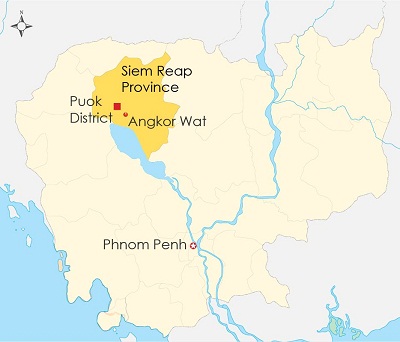
The city of Siem Reap, also the capital of the province, is a ‘must-visit’ destination for all visitors to Cambodia. This is where the glorious 12th Century Angkor Wat temple, the largest religious building in the world, is located. Situated on the northern bank of the Tonle Sap Great Lake, this mesmerizing eighth wonder of the world can be easily accessed by plane, land, and boat.
The ruins of Angkor, located in thick jungle, are now a UNESCO World Heritage Site. There are over one thousand temples ranging in scale from nondescript piles of rubble scattered through rice fields to the awe-inspiring Angkor Wat--the best-preserved temple.
Apart from the legacy of the vast Angkor temple complex, Siem Reap has a lot more to offer to tourists, from the spectacular floating village on the Tonle Sap Lake to the heritage site of the Kulen Mountain, to the recently discovered Koh Ker ruins.
In town, there are a bevy of ethnic craft shops, galleries, cafes, eateries and top-notch restaurants serving every type of cuisine. The famous ‘Pub Street’ and the night markets of Siem Reap are now renowned tour destinations in their own rights. Additionally, siilk farms, rice-paddy countryside, fishing villages and a very rich bird sanctuary near the Tonle Sap Lake makeSiem Reap one of the most captivating places in the world.
SIEM REAP TOURIST ATTRACTIONS
Angkor Wat - Heritage of Humanity and World Wonder
Constructed: Early – Mid 12th century C.E.
Religion: Hinduism
King/Patron: Suryavarman II
Style: Angkor Wat
Angkor Wat which literally means ‘City Temple’ is a Hindu temple complex built to replicate the heavens on earth.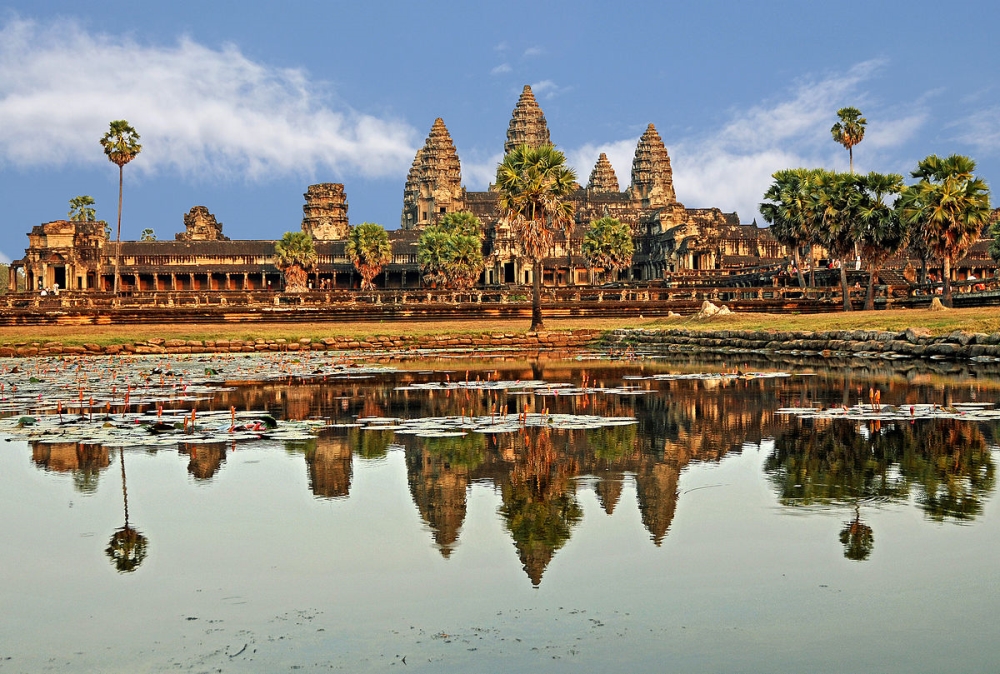 Constructed for King Suryavarman II in the early twelfth century, it is the best-preserved temple and is the only one to have remained a significant religious centre since its foundation; first Hindu, dedicated to Vishnu, then Buddhist. The temple is the epitome of the high classical style of Khmer architecture. This magnificent temple combines two basic plans of Khmer temple architecture; the temple mountain and the later galleried temple, based on early South Indian Hindu architecture. Constructed within a moat and an outer wall 3.6 kilometres (2.2 miles) long with three rectangular galleries, each raised above the next, it is designed to represent Mount Meru, home of the devas in Hindu mythology.
Constructed for King Suryavarman II in the early twelfth century, it is the best-preserved temple and is the only one to have remained a significant religious centre since its foundation; first Hindu, dedicated to Vishnu, then Buddhist. The temple is the epitome of the high classical style of Khmer architecture. This magnificent temple combines two basic plans of Khmer temple architecture; the temple mountain and the later galleried temple, based on early South Indian Hindu architecture. Constructed within a moat and an outer wall 3.6 kilometres (2.2 miles) long with three rectangular galleries, each raised above the next, it is designed to represent Mount Meru, home of the devas in Hindu mythology.
At the centre of the temple stands a quincunx of towers. Unlike most Angkorian temples, Angkor Wat is oriented to the west and this has scholars divided as to its significance. The temple is admired for the grandeur and harmony of the architecture. The extensive bas-reliefs and the numerous guardian spirits adorning its walls serve as evidence of the strong Khmer religious beliefs.
Angkor Thom Temple
Constructed: Late 12th – Early 13th century C.E.
Religion: Buddhism
King/Patron: Jayavarman VII
Style: Bayon
Angkor Thom is a very popular tourist spot. It was established in the late twelfth century to early thirteenth century by King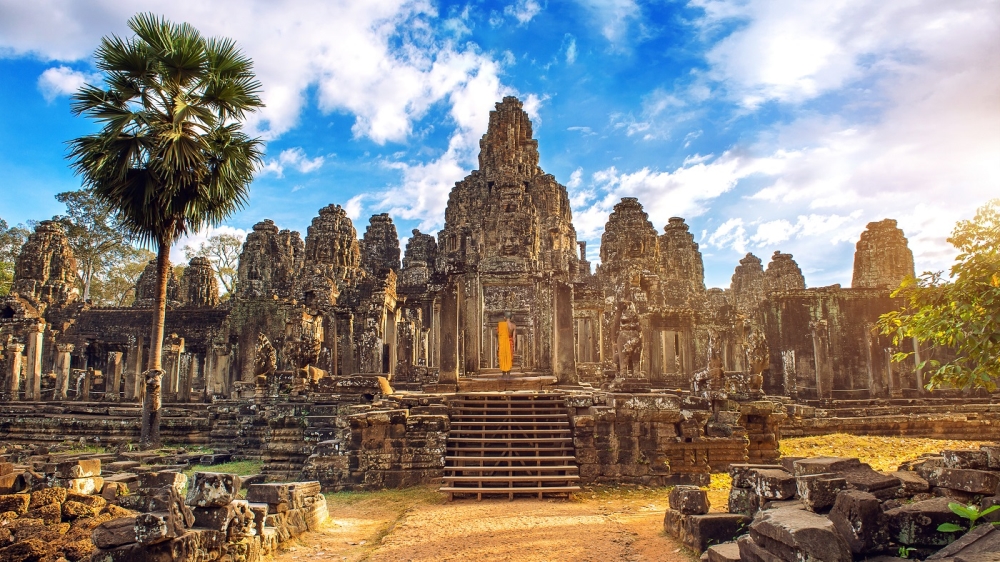 Jayavarman VII. This site is situated 1.7 Km north of Angkor Wat, within which are located several monuments from earlier eras as well as those established by Jayavarman and his successors.
Jayavarman VII. This site is situated 1.7 Km north of Angkor Wat, within which are located several monuments from earlier eras as well as those established by Jayavarman and his successors.
The fortified city of Angkor Thom, some 9sq km in extent, was the last and most enduring capital city of the Khmer empire built by Angkor’s greatest King, Jayavarman VII (ruled 1181-1201).
Centered on Baphuon, Angkor Thom is enclosed by a square wall 8m high and 12km in length and encircled by moat 100m wide. The city has five monumental gates, one each in the north, west and south walls and two in the east wall. In front of each gate stand giant statues of 54 gods (to the left of the causeway) and 54 demons (to the right of the causeway), a motif taken from the story of the Churning of the Ocean of Milk illustrated in the famous bas-relief at Angkor Wat. In the center of the walled enclosure are the city’s most important monuments, including the Bayon, the Baphuon, the Royal Enclosure, Phimeanakas and the Terrace of Elephants.
Bayon Temple
Constructed: Late 12th century C.E.
Religion: Buddhist
King/Patron: Jayavarman VII
Style: Bayon
Bayon is a richly decorated Khmer temple built in the late twelfth century or early thirteenth century. Built at the centre of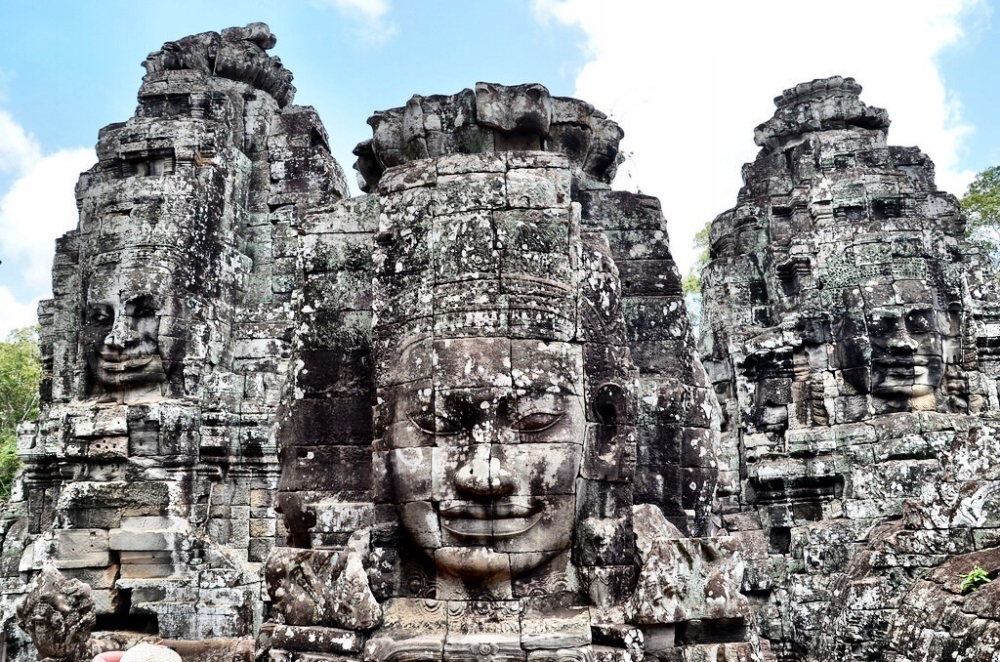 King Jayavarman’s capital, Angkor Thom was the last state temple to be built at Angkor, and the only Angkorian state temple to be built primarily as a Mahayana Buddhist shrine dedicated to the Buddha. Following Jayavarman’s death, it was modified and augmented by later Hindu and Theravada Buddhist kings in accordance to their religious preferences.
King Jayavarman’s capital, Angkor Thom was the last state temple to be built at Angkor, and the only Angkorian state temple to be built primarily as a Mahayana Buddhist shrine dedicated to the Buddha. Following Jayavarman’s death, it was modified and augmented by later Hindu and Theravada Buddhist kings in accordance to their religious preferences.
Bayon’s most distinctive feature is the multitude of serene and massive stone faces on the many towers that jut from the upper terrace and cluster around its center peak. The similarity of the 216 gigantic faces to other statues of Jayavarman VII has led many scholars to the hypothesise that the faces are representations of the king himself. Others believe that the faces belong to Avalokitesvara, the bodhisattva of compassion.
The temple is also popular for two impressive sets of bas-reliefs, which present an unusual combination of mythological, historical, and mundane scenes. This is one of the many ‘must visit’ temples.
Banteay Srei Temple
Constructed: Late 10th century C.E.
Religion: Hindu (Shiva)
King/Patron: Rajendravarman
Style: Banteay Srey
Consecrated in 967 A.D, Banteay Srei was speculated to have been known earlier as Banteay Serai, which literally means the Citadel of Victory. This was the only major temple at Angkor not built by a monarch; its construction is credited to a courtier named Yajnavaraha, who was a scholar and philanthropist and a counselor to king Rajendravarman. He was known to have helped those who suffered from illness, injustice or poverty.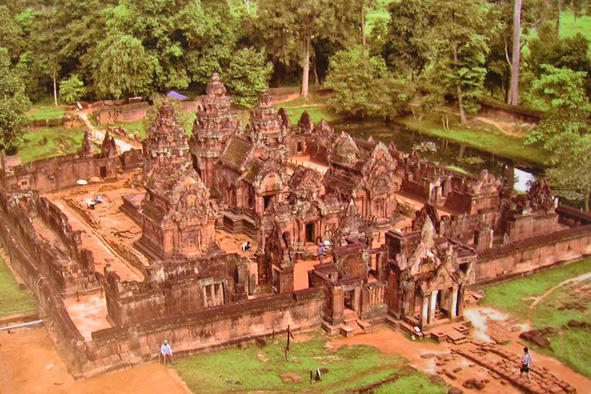
Banteay Srei is built primarily in red sandstone, a medium that lends itself to the elaborate decorative wall carvings which are still observable in fine details today. Measured by the standards of Angkorian construction, the buildings themselves are miniature in scale. These factors have led to its being widely praised as a ‘precious gem’, or the ‘jewel of Khmer art’ and perhaps the temple’s modern name, Banteay Srei or Citadel of Women, is probably related to the intricacy of the bas relief carvings of devatas found on the walls and the tiny dimensions of the buildings themselves.
Phnom Bakheng
Constructed: Late 9th – Early 10th century C.E.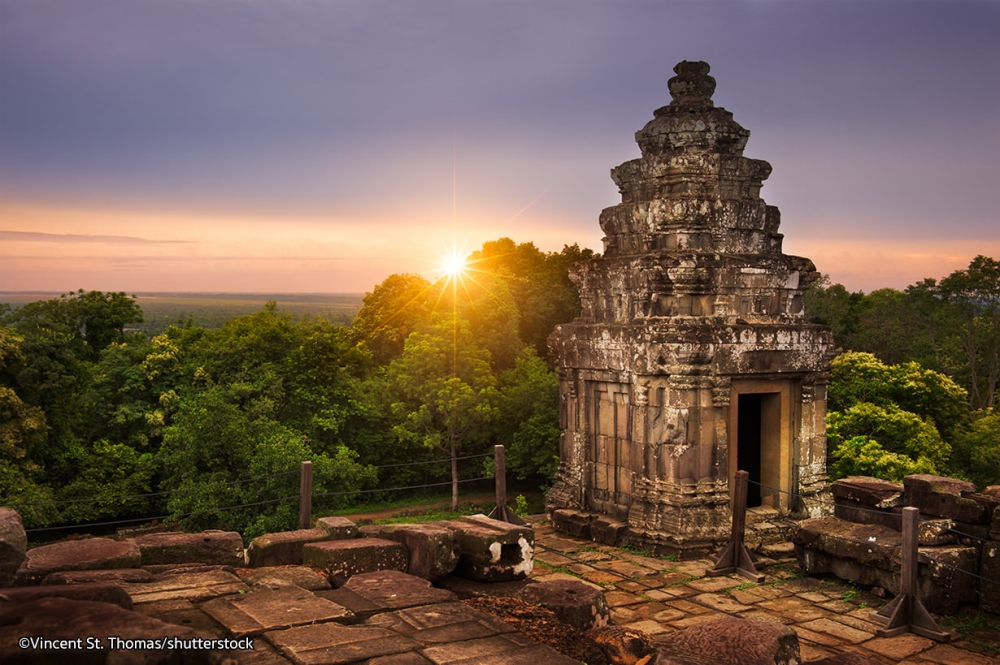
Religion: Hindu (Shiva)
King/Patron: Yasovarman I
Style: Bakheng
Phnom Bakheng was constructed more than two centuries before the Angkor Wat. It is a Hindu temple originally built in the form of a temple mountain dedicated to Shiva. Historians believe that Phnom Bakheng was in its heyday, the principal temple of the Angkor region. It was the architectural centerpiece of a new capital that Yasovarman built when he moved the court from the capital Hariharalaya in the Roluos area located to the southeast.
Located atop a hill, this is the most popular tourist spot for sunset views of the much bigger Angkor Wat temple which lies amid the jungle about 1.5 km away.
Preah Khan Temple
Constructed: Late 12th century C.E.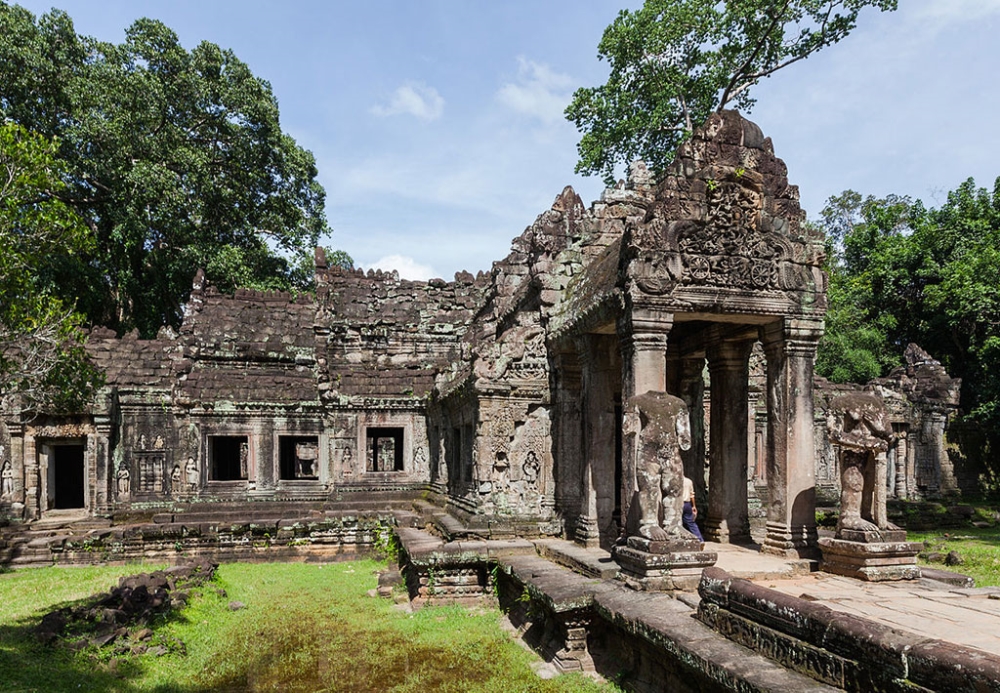
Religion: Buddhist
King/Patron: Jayavarman VII
Style: Bayon
Preah Khan was built on the site of Jayavarman VII’s victory over the invading Chams in 1191.
In its heyday, this was the centre of a substantial organisation with almost 100,000 officials and servants. This temple is flat in design, with a basic plan of successive rectangular galleries around a Buddhist sanctuary complicated by Hindu satellite temples and numerous later additions. With numerous trees and other vegetation growing among the ruins, Preah Khan has been left largely unrestored.
Ta Prohm Temple
Constructed: Mid 12th - Early 13th century C.E.
Religion: Buddhist
King/Patron: Jayavarman VII
Style: Bayon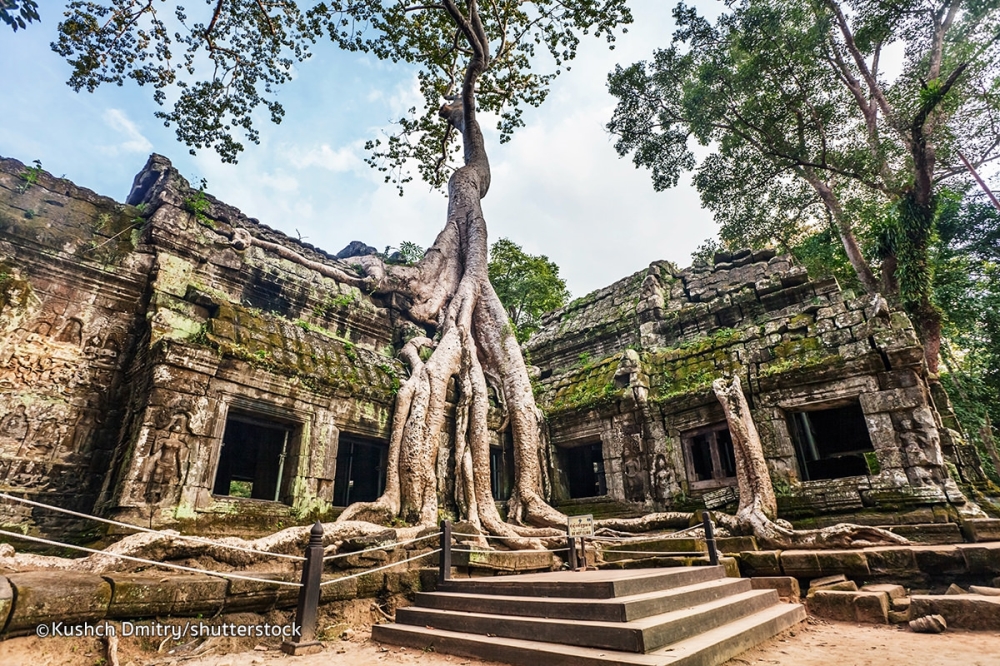
Ta Prohm, a Bayon style temple, is believed to be built in the late twelfth and early thirteenth centuries. It was founded by King Jayavarman VII as a Mahayana Buddhist monastery and university. Unlike most Angkorian temples, Ta Prohm has been left in much the same condition in which it was found where the photogenic and atmospheric combination of trees growing out of the ruins and the jungle surroundings have made it one of Angkor’s most popular temples with visitors.
Rajavihara (Royal temple), as it was originally known, was one of the first temples founded pursuant to a massive program of construction and public works after the King’s ascension to the throne in 1811 A.D.. It was built in honor of his family. The temple’s main image, representing Prajnaparamita, the personification of wisdom, was modeled on the king’s mother. The northern and southern satellite temples in the third enclosure were dedicated to the king’s guru and his elder brother respectively. As such, Ta Prohm formed a complementary pair with the temple monastery of Preah Khan, dedicated in 1191 A.D., the main image of which represented Avelokitesvara, the Bodhisattva of compassion and was modeled on the king’s father.
The site was home to more than 12,500 people (including 18 high priests and 615 dancers), with an additional 80,000 people in the surrounding villages working to provide services and supplies.
Banteay Kdei Temple
Constructed: Late 12th - Early 13th century C.E.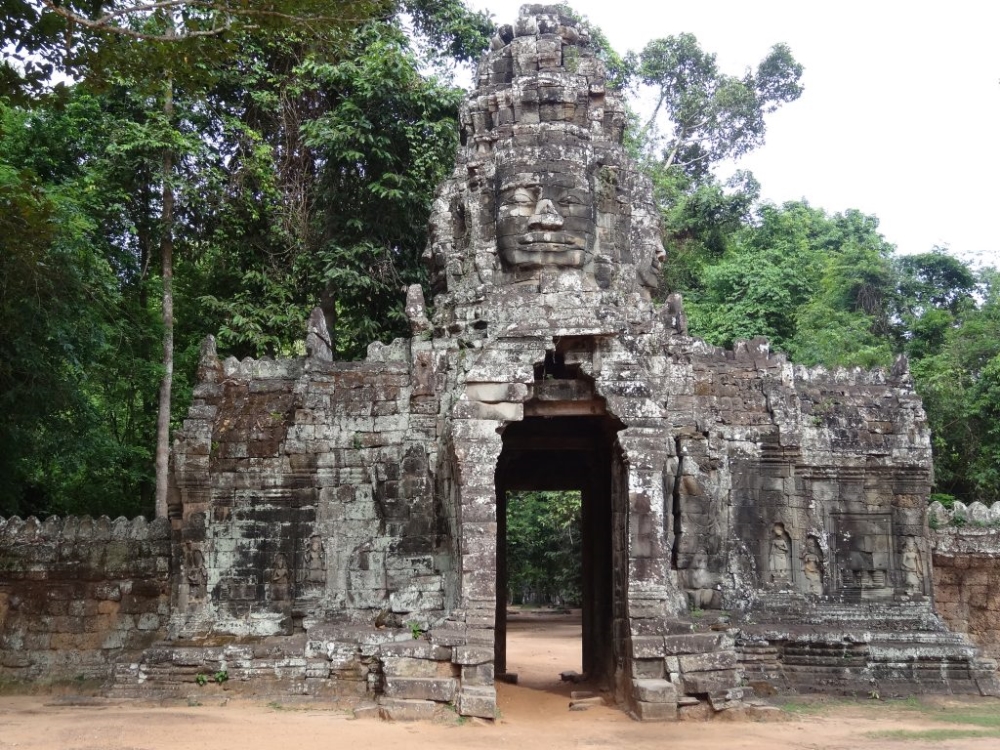
Religion: Buddhist
King/Patron: Jayavarman VII
Style: Angkor Wat/Bayon
Built in the late twelfth to early thirteenth century during the reign of Jayavarman VII, Banteay Kdei is known only as a Buddhist temple constructed in the Bayon style. It has been occupied by monks at various intervals over the centuries, but the inscription stone has never been discovered so it is mystery; unknown to whom the temple is dedicated.
Its structures are contained within two successive enclosure walls, and consist of two concentric galleries from which emerge towers, preceded to the east by a cloister. Like all the other ruins in Angkor, the carvings are captivating.
Kulen Mountain National Park
Constructed: 9th century C.E.
Religion: Hindu
King/Patron: Jayavarman II
Style: Kulen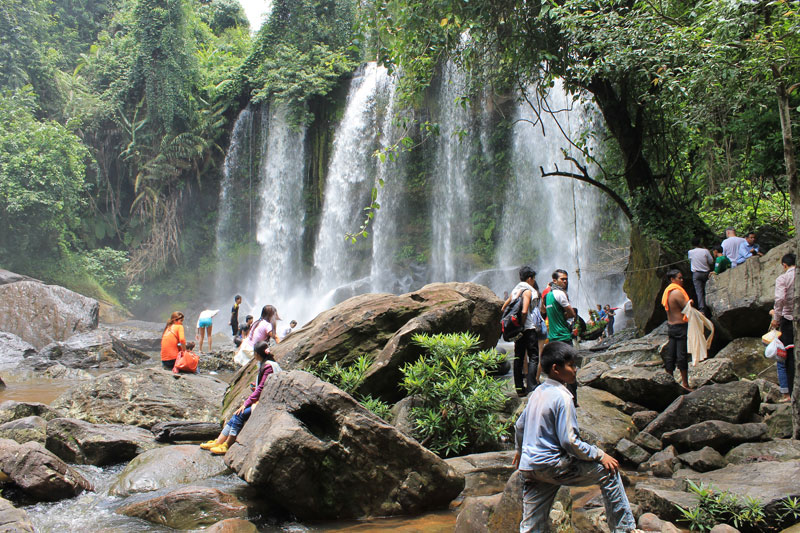
The Kulen Mountain or Phnom Kulen is declared as a National Park. It is an isolated mountain massif located in Svay Leu District and some 48km from Siem Reap. Its highest point is 487 meters.
This is widely regarded as the birthplace of the ancient Khmer Empire. During the constructional period of the ancient temples in the nineth century, sand stones were brought from this sacred mountain to Angkor. It was here at Phnom Kulen that King Jayavarman II proclaimed independence from Java in 802 A.D.
The site is known for its carvings representing fertility and its waters hold special significance to the people of Cambodia. Just a few inches under the surface of the water, over 1000 carvings of Yoni and Linga are etched into the sandstone riverbed. The waters are regarded as holy, given the sacred carvings which also include a stone representation of the Hindu god Vishnu lying on his serpent Ananta, with his wife Lakshmi at his feet. A lotus flower protrudes from Vishnu’s navel bearing the god Brahma. The river then ends with a beautiful waterfall. Phnom Kulen is regarded highly by Cambodian people as a sacred location and has developed into a great tour destination.
Angkor National Museum
The Angkor National Museum is classified as one of Cambodia’s premier museum sites. On display are thousands of important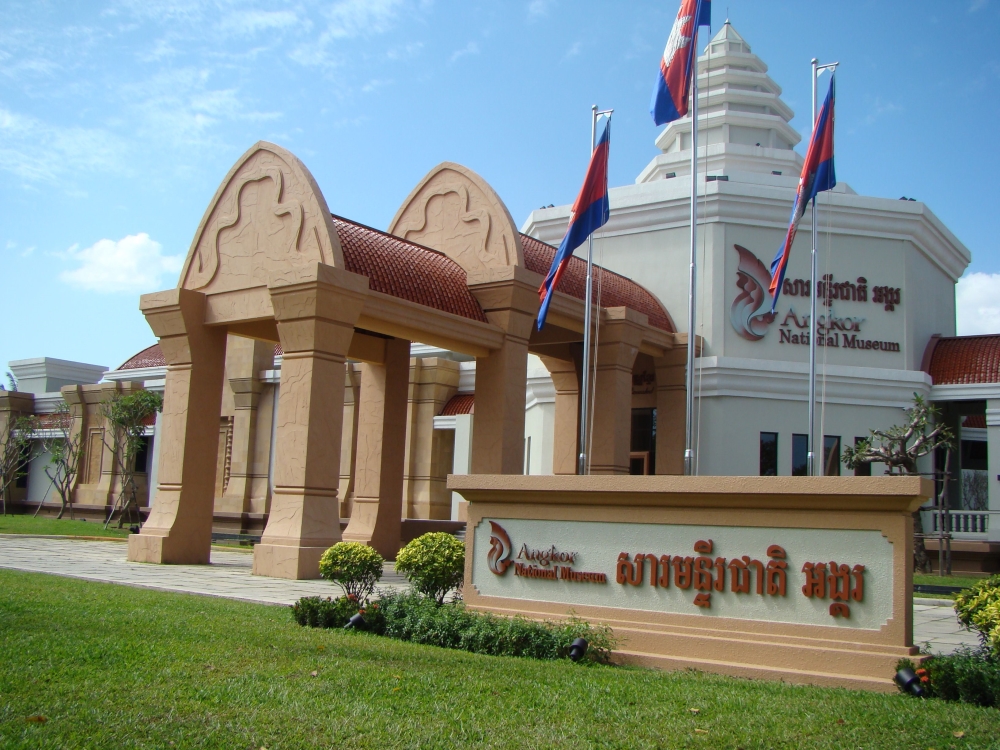 Buddhist and Hindu sculptures from the various Angkor temples.
Buddhist and Hindu sculptures from the various Angkor temples.
Many original pieces recovered for safe-keeping by the authorities from the temple ruins are also on exhibit at this museum.
Since the discovery of the Angkor temples, many of the antique artifacts have been stolen and sold to private collectors, museums and auction houses all over the world. Over the years, efforts have been made by the Royal Cambodian government to recover them and with the cooperation of various government agencies from around the world, many of the lost pieces have found their way back to Cambodia.
The Angkor National Museum houses and exhibits many of the recovered items amongst the several thousand exhibits now on display. In this very modern building, tourists will discover the Golden Era of the Khmer Kingdom and through state of the art multimedia technology, enjoy a full story of the legend.
Cultural Village
The Cambodian Cultural Village is designed to provide tourists with an excellent insight into the life and culture of the Cambodians; their traditions and practices, etc.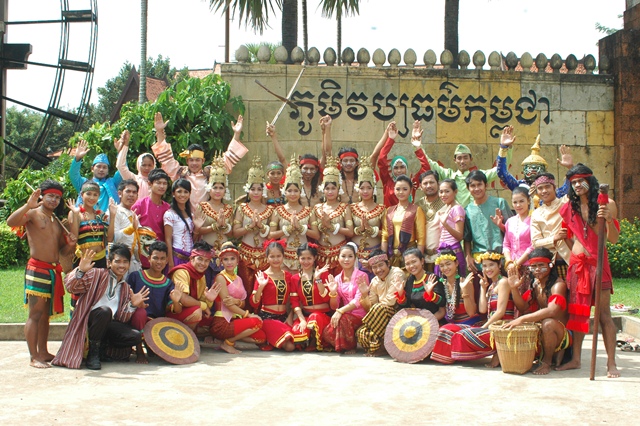
In all, eleven villages or sectors, each a showcase of different landmarks and providing a peek into the lifestyles of the people from various provinces including the ethnic minorities.
Like a theme park, tourists are treated to miniatures of historical buildings, stone carvings, wood works and many forms of arts and crafts.
There are performances; dances of the ethnic groups, traditional wedding ceremony, circus acts, acrobats, elephant shows, Khmer boxing, the famous Apsara dance and more to entertain the tourists.
Night Market
Like the one in Phnom Penh, the Angkor Night Market is also designed to give visitors a secure and enjoyable shopping and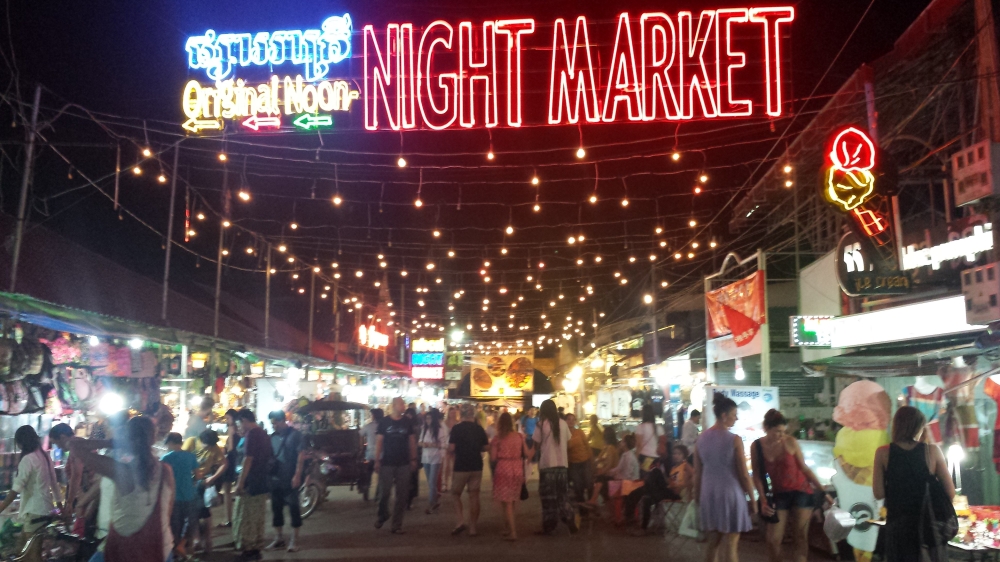 dining experience in a vibrant, contemporary Khmer environment. Both these night markets offer a wide variety of stalls offering a diverse range of goods and services. A ‘must visit’ when in the vicinity.
dining experience in a vibrant, contemporary Khmer environment. Both these night markets offer a wide variety of stalls offering a diverse range of goods and services. A ‘must visit’ when in the vicinity.
Kravan Temple
Built by King Harshavarman I in the early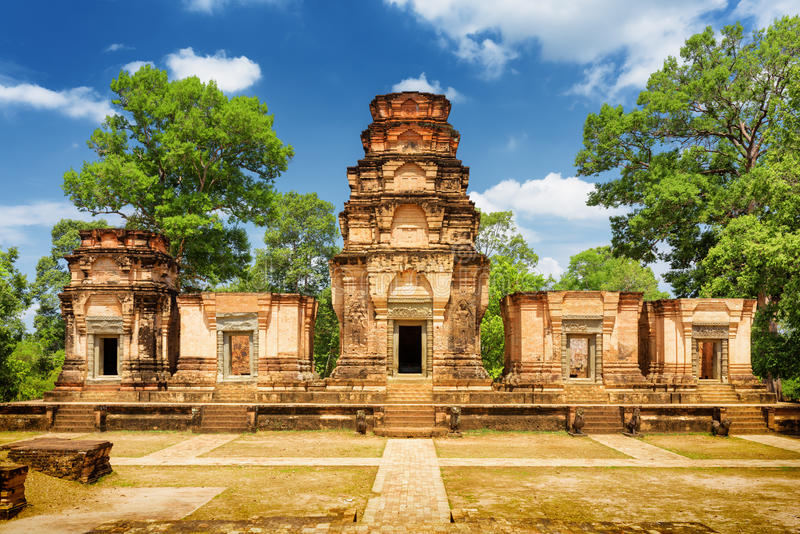 10th century and dedicated to Hindusim.
10th century and dedicated to Hindusim.
Location: East of Angkor Wat and south of Banteay kdei
Access: Enter and depart from the east
Date: The first half of the tenth century (921)
King: Completed during the reign of Harshavarman I (it may have been built by high court officials)
Art Style: Transitional from Bakheng to Kho Ker.
Terrace of the Elephants
The Terrace of the Elephants is part of the walled city of Angkor Thom. The terrace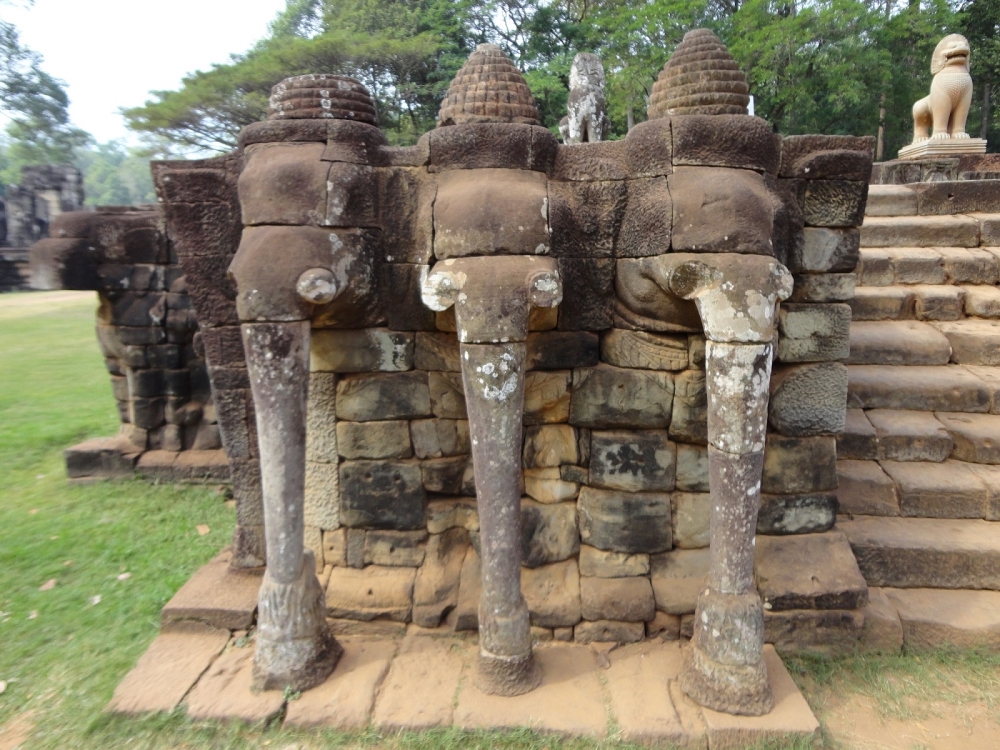 was used by king Jayavarman VII as a platform from which to view his victorious returning army. It was attached to the palace of Phimeanakas. Most of the original structure was made of organic material and has long since disappeared and most of what remains are the foundation platforms of the complex. The terrace is named for the carvings of elephants on its eastern side.
was used by king Jayavarman VII as a platform from which to view his victorious returning army. It was attached to the palace of Phimeanakas. Most of the original structure was made of organic material and has long since disappeared and most of what remains are the foundation platforms of the complex. The terrace is named for the carvings of elephants on its eastern side.
The 350m-long Terrace of Elephants was used as a giant reviewing stand for public ceremonies and served as a base for the king's grand audience hall. It has five outworks extending towards the Central Square-three in the centre and one at each end. The middle section of the retaining wall is decorated with life size garudas and lions; towards either end are the two parts of the famous parade of elephants complete with their Khmer mahouts.
Srah Srang ‘the royal bath’
It was perhaps a chapel to Kama, God of Love. The spot would suit the temper of the strange power, terribly strong and yet terribly tender, and of that passion which carries away kingdoms, empires and whole worlds. Love could occupy this quiet nest embedded in water, which gave the impression that love had come one day and had left there, when he went away, a part of his spirit.
terribly tender, and of that passion which carries away kingdoms, empires and whole worlds. Love could occupy this quiet nest embedded in water, which gave the impression that love had come one day and had left there, when he went away, a part of his spirit.
East Mebon Temple
East Mebon temple is a large temple-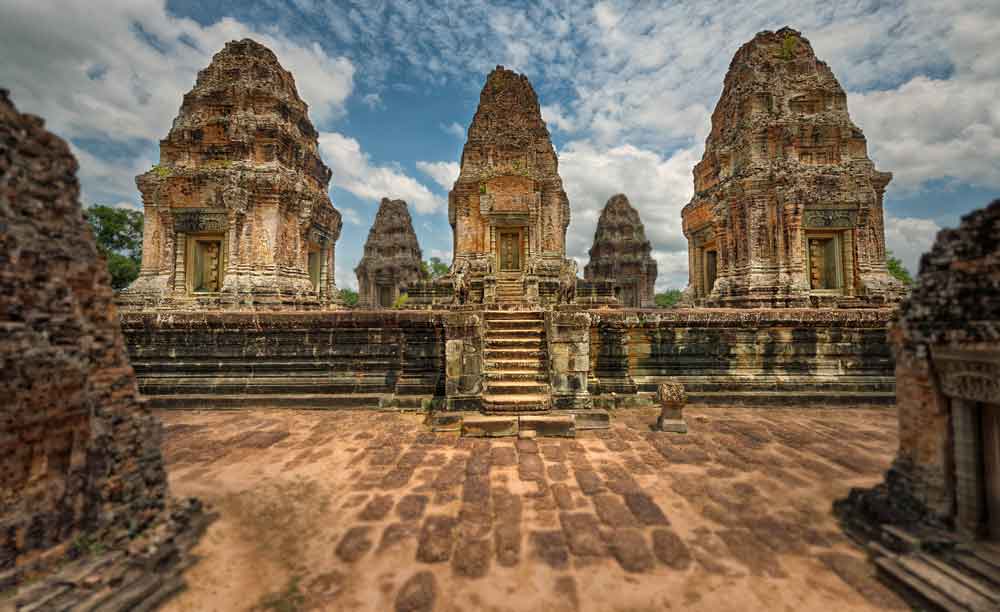 mountain-like ruin, rising three levels and crowned by five towers. Jayavarman IV, a usurper to the throne, moved the capital from Angkor to Koh Ker in 928AD. Sixteen years later Rajendravarman II returned the capital to Angkor and shortly thereafter constructed East Mebon on an island in the middle of the now dry Eastern Baray. The temple is dedicated to shiva in honor of the king’s parents. Inscriptions indicate that it was also built to help reestablish the continuity of kingship at Angkor in light of the interruption that occurred when the seat of power had been moved to Koh Ker. There seems to be some scholarly debate as to whether East Mebon should be categorized as a temple-mountain. Inscriptions record activity at the temple as early as 947AD, but East Mebon was not consecrated until 952AD.
mountain-like ruin, rising three levels and crowned by five towers. Jayavarman IV, a usurper to the throne, moved the capital from Angkor to Koh Ker in 928AD. Sixteen years later Rajendravarman II returned the capital to Angkor and shortly thereafter constructed East Mebon on an island in the middle of the now dry Eastern Baray. The temple is dedicated to shiva in honor of the king’s parents. Inscriptions indicate that it was also built to help reestablish the continuity of kingship at Angkor in light of the interruption that occurred when the seat of power had been moved to Koh Ker. There seems to be some scholarly debate as to whether East Mebon should be categorized as a temple-mountain. Inscriptions record activity at the temple as early as 947AD, but East Mebon was not consecrated until 952AD.
Pre Roup Temple
Architecturally and artistically superior temple-mountain. Beautifully carved false doors on upper level, as well as an excellent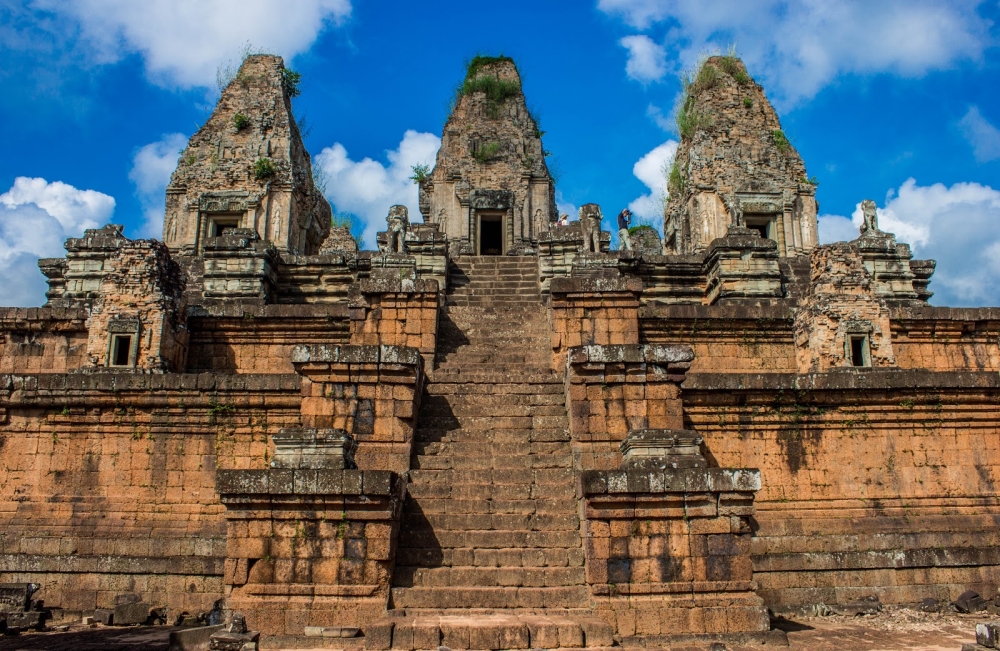 view of the surrounding countryside. Richly detailed, Well-preserved carvings. Traditionally believed to be a funerary temple, but in fact the state temple of Rajendravarman II. Historically important in that it was the second temple built after the capital was returned to Angkor from Koh Ker after a period of political upheaval. The artistically similar East Mebon was the first to be constructed after the return to Angkor, less than a decade earlier.
view of the surrounding countryside. Richly detailed, Well-preserved carvings. Traditionally believed to be a funerary temple, but in fact the state temple of Rajendravarman II. Historically important in that it was the second temple built after the capital was returned to Angkor from Koh Ker after a period of political upheaval. The artistically similar East Mebon was the first to be constructed after the return to Angkor, less than a decade earlier.
River of One-Thousand Lingas
It is located at the foot of the mountain.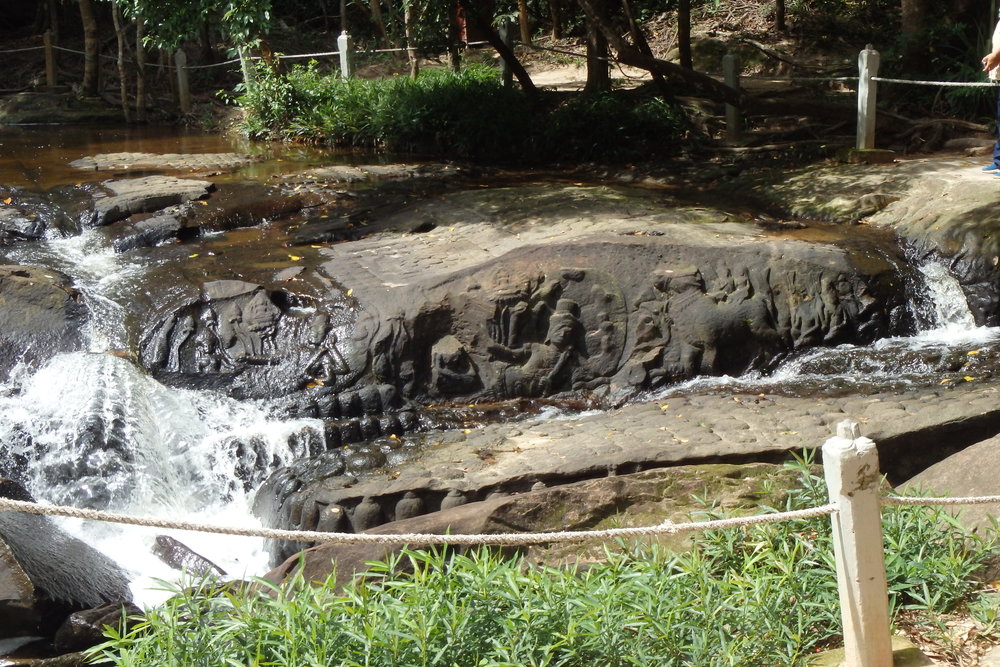
Kbal Spean
This holy place must have been favored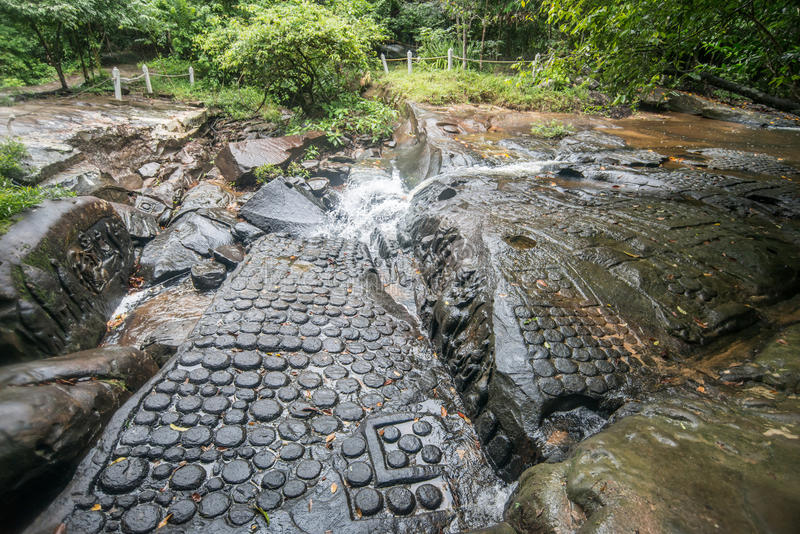 during the great Angkorean epoch when its waters, after having washed gods and lingas, continued on to the wondrous royal city with its growing monumental temples.
during the great Angkorean epoch when its waters, after having washed gods and lingas, continued on to the wondrous royal city with its growing monumental temples.
Baksei Chamkrong
Constructed: Mid 10th century C.E.
Religion: Hindu (Shiva)
King/Patron: Harshavarman I
Style: Bakheng
A towering 12-meter tall brick and laterite step-pyramid. Harshavarman I began construction or perhaps dedicated
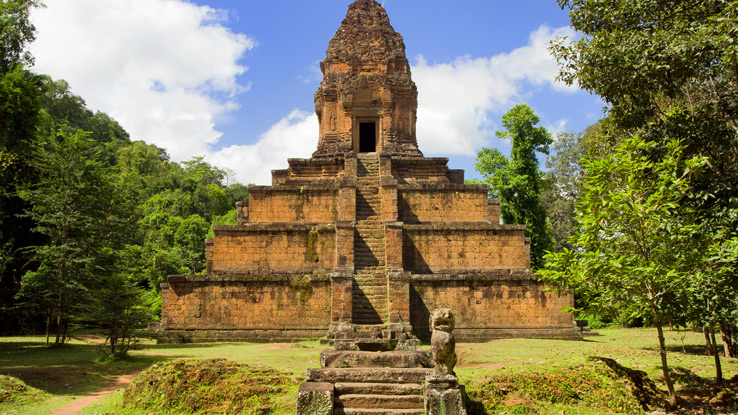 statues at the site in the early 10th century. It was later improved/restored by Rajendravarman II shortly after the capital was returned to Angkor from Koh Ker. According to inscriptions on the doorway, Rejendravarman II consecrated with the installation of a golden Shiva image in 947AD.
statues at the site in the early 10th century. It was later improved/restored by Rajendravarman II shortly after the capital was returned to Angkor from Koh Ker. According to inscriptions on the doorway, Rejendravarman II consecrated with the installation of a golden Shiva image in 947AD.
It may have also served as a funerary temple. Combine with a visit to the South Gate in the morning or Phnom Bakheng in the evening. Lighting is best in the morning.
Banteay Prei
Constructed: Late 12th - Early 13th century C.E. Religion: Buddhist
King/Patron: Jayavarman VII
Style: Bayon
Small, untouristed temple near Neak Pean. Similar to Ta Som in architectural/artistic style and scale. Some of the apsara and Buddhist-themed lintel carvings are in pretty good condition. Oddly small doors and windows. Quiet, meditative spot.
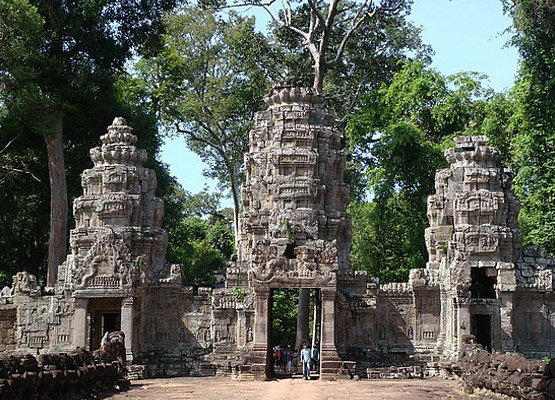
Banteay Samre
Constructed: Mid 12th century C.E.
Religion: Hindu (Shiva)
King/Patron: Suryavarman II
Style: Angkor Wat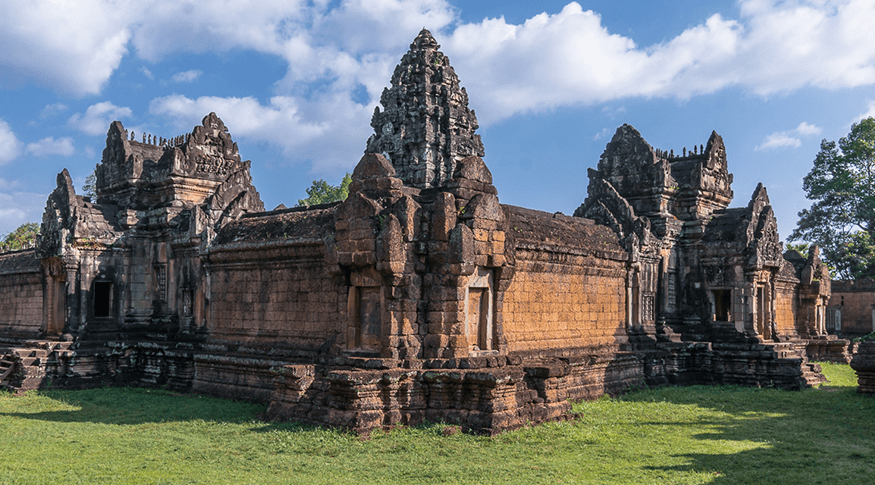
Large, comparatively flat temple displaying distinctively Angkor Wat-style architecture and artistry. The temple underwent extensive restoration this century by archaeologists using the anastylosis method. Banteay Samre was constructed around the same time as Angkor Wat. The style of the towers and balustrades bear strong resemblance to the towers of Angkor Wat and even more so to Khmer temple of Phimai in Thailand. Many of the carvings are in excellent condition. Banteay Samre id a bit off the Grand Circuit, near the southeast corner of the East Baray. The trip there is a nice little 3km road excursion through villages and paddies. Combine a visit to Banteay Srey with a stop at Banteay Samre on the way back.
Baphoun
Constructed: Mid 11th century C.E.
Religion: Hindu
King/Patron: Udayadityavarman II
Style: Baphuon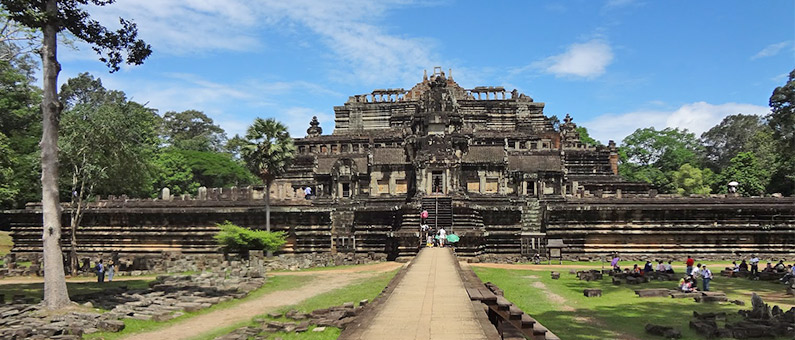
Baphuon: Huge temple-mountain in the heart of Angkor Thom. Largely collapsed and in ruined condition, the main temple area is undergoing extensive restoration. Most of the construction area is not open to the public but over the last several months, certain areas have begun to open to the public. The exterior entry gate and elevated causeway are open as well as some areas around the perimeter of the construction. Note the unique animal carving at the walkway entrance. Similar carvings are visible on West Mebon. Also note the large reclining Buddha on the west side, which was added to the temple at a much later period.
Barays
A ´baray´ is a water reservoir – an area of land where dikes have been raised to catch and hold water. Beginning in the 9th century, the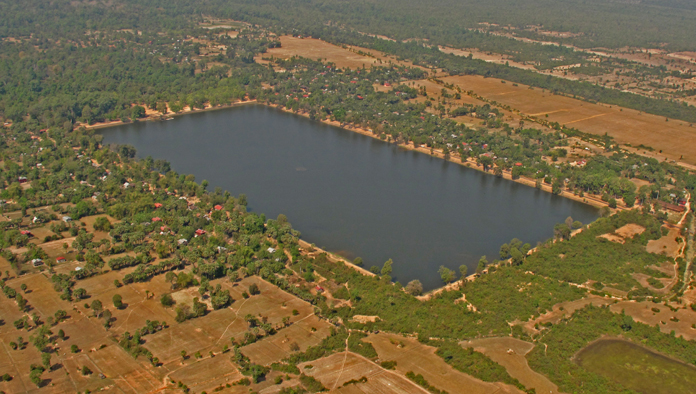 construction of massive baray and other such grand projects became one of the marks of Angkorian kingship. There are four major barays in the Park area. When the barays were constructed, an island temple was set at the center of each. The first major baray to be constructed was Indratataka by King Yasovarman I, measuring 3.8km x 880m and completed in 889AD when the capital was still at Hariharalaya near Roluos. The Roluos Group temple Lolei sat on an island in the middle of Indratataka. Construction of the second major baray, the East Baray (Yashodharatataka.) began almost immediately after the first. At 7.8km x 880m it was almost five times larger than the Indratataka. Almost 50 years later, the temple East Mebon was constructed on an island in the center. The third and largest baray (8km x 2.2km) is the West Baray built in the early 11 th century, Unlike the other barays, the West Baray is still partially filled, creating good sized lake. The temple ruins of West Mebon sit on an artificial island at the center of the baray (requiring a short boat ride to visit.) The last baray (Jayatataka) was constructed by Jayavarman VII in the late 12 th century. It is considered to be the baray of Preah Khan though it is Neak Pean that actually sits at the center. The function of baray is a matter of academic debate. A recent study has argued that the barays did not serve an agricultural purpose but were built and maintained solely for political/religious reasons. Conventional wisdom has it that the barays were part of a giant water works used to irrigate the rice paddies and provide water for year round cultivation, though they certainly served a political and religious function as well.
construction of massive baray and other such grand projects became one of the marks of Angkorian kingship. There are four major barays in the Park area. When the barays were constructed, an island temple was set at the center of each. The first major baray to be constructed was Indratataka by King Yasovarman I, measuring 3.8km x 880m and completed in 889AD when the capital was still at Hariharalaya near Roluos. The Roluos Group temple Lolei sat on an island in the middle of Indratataka. Construction of the second major baray, the East Baray (Yashodharatataka.) began almost immediately after the first. At 7.8km x 880m it was almost five times larger than the Indratataka. Almost 50 years later, the temple East Mebon was constructed on an island in the center. The third and largest baray (8km x 2.2km) is the West Baray built in the early 11 th century, Unlike the other barays, the West Baray is still partially filled, creating good sized lake. The temple ruins of West Mebon sit on an artificial island at the center of the baray (requiring a short boat ride to visit.) The last baray (Jayatataka) was constructed by Jayavarman VII in the late 12 th century. It is considered to be the baray of Preah Khan though it is Neak Pean that actually sits at the center. The function of baray is a matter of academic debate. A recent study has argued that the barays did not serve an agricultural purpose but were built and maintained solely for political/religious reasons. Conventional wisdom has it that the barays were part of a giant water works used to irrigate the rice paddies and provide water for year round cultivation, though they certainly served a political and religious function as well.
Bat Chum
Constructed: Mid 10th century C.E.
Religion: Buddhist
King/Patron: Rajaendravarman
Style: Pre Rup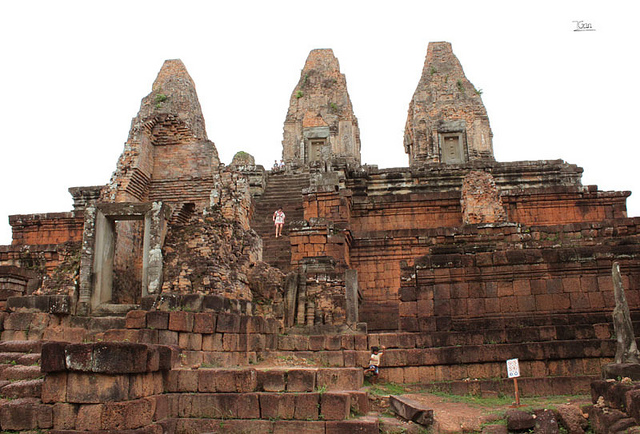
Trio of small brick towers on a platform with two surviving lintels in pretty good condition. Bat Chum is a historically unique early Buddhist temple constructed at a time when Hinduism dominated. The inscriptions on the doorways note the Buddhist dedication, praise the architect (who was also the architect for East Mebon and Pre Rup,) and admonishes local elephant handlers to keep their beasts off the dikes, like an ancient ´keep off the grass´ sign. Follow unmarked dirt road between Pre Rup and Srah Srang about 1km.
Chapel of the Hospital
Constructed: Mid 12th century C.E.
Religion: Buddhist
King/Patron: Jayavarman VII
Style: Bayon
102 hospitals were built throughout the empire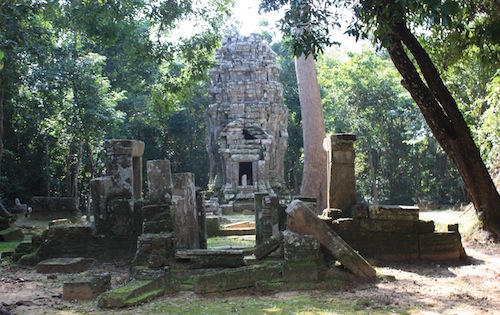 under Jayavarman VII. The hospital itself was probably constructed of perishable materials such as wood and bamboo, which has long since disappeared, leaving only the sandstone hospital temple or ´chapel´ for the ages. This temple and the one at Ta Prohm Kel opposite Angkor Wat offer two examples of hospital temples. Constructed of sandstone, this Chapel of the Hospital is in rough condition but some carvings are still visible. A quiet, meditative spot, easily accessible but visited by few tourists.
under Jayavarman VII. The hospital itself was probably constructed of perishable materials such as wood and bamboo, which has long since disappeared, leaving only the sandstone hospital temple or ´chapel´ for the ages. This temple and the one at Ta Prohm Kel opposite Angkor Wat offer two examples of hospital temples. Constructed of sandstone, this Chapel of the Hospital is in rough condition but some carvings are still visible. A quiet, meditative spot, easily accessible but visited by few tourists.
Chau Say Tevoda
Constructed: Early 12th century C.E.
Religion: Hindu
King/Patron: Suryavarman II
Style: Angkor Wat
Chau Say Tevoda is a small temple of similar design and floor plan to that of Thommanon located across the street (except for additional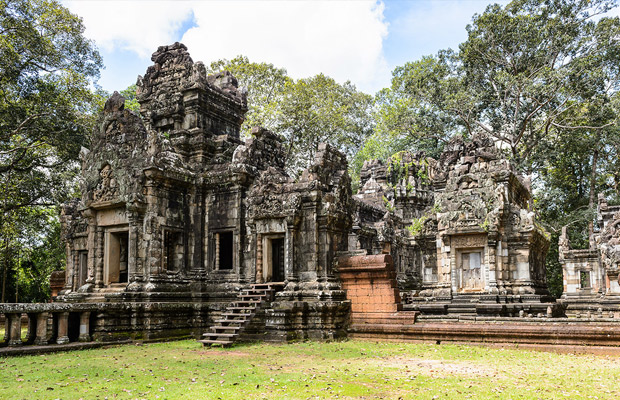 gopuras and library), but for years appeared as Thommanon´s neglected sister, languishing in significantly worse condition than Thommanon, which had been restored back in the 1960s. Chau Say Tevoda is now undergoing an extensive restoration project, for the moment allowing the visitor a close up look at the restoration process. Significant progress has been made and the temple is quickly taking shape once again. Chau Say Tevoda seems to stand in partnership with Thommanon, but in fact condition, especially those on the eastern gopura. Though most carving are Hindu-themed, there are also some Buddhaist themed reliefs. The eastern walkway as 947AD, but East Mebon was not consecrated until 952AD.
gopuras and library), but for years appeared as Thommanon´s neglected sister, languishing in significantly worse condition than Thommanon, which had been restored back in the 1960s. Chau Say Tevoda is now undergoing an extensive restoration project, for the moment allowing the visitor a close up look at the restoration process. Significant progress has been made and the temple is quickly taking shape once again. Chau Say Tevoda seems to stand in partnership with Thommanon, but in fact condition, especially those on the eastern gopura. Though most carving are Hindu-themed, there are also some Buddhaist themed reliefs. The eastern walkway as 947AD, but East Mebon was not consecrated until 952AD.
Kleangs (North and South)
Constructed: Late 10th – Early 11th century C.E.
Religion: Hindu
King/Patron: Jayavarman V
Style: Kleang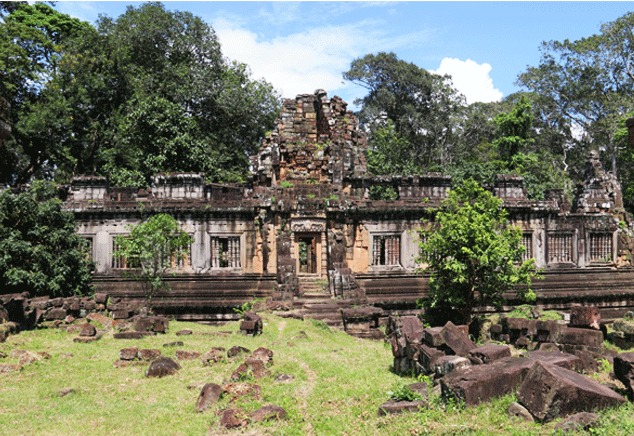
Rectangular sandstone building set opposite the Terrace of Elephants, behind the Prasat Suor Prat. ‘Kleang’ means ‘storeroom’ but it is unlikely that this was its actual function. A royal oath of allegiance carved into the doorway indicates that they may have served as reception areas or even housing for visiting noblemen and ambassadors. The North Kleang was built in wood under Rajendravarman II and then rebuilt in stone by Jayavarman V, probably before the construction of the South Kleang. It also contains the best preserved carvings. The South Kleang was never completed. The Kleangs are unremarkable upon close inspection but picturesque from a distance, standing among the Prasat Suor Prat. Best photographed in the afternoon.
Krol Ko
Constructed: Late 12th century C.E.
Religion: Buddhist
King/Patron: Jayavarman VII
Style: Bayon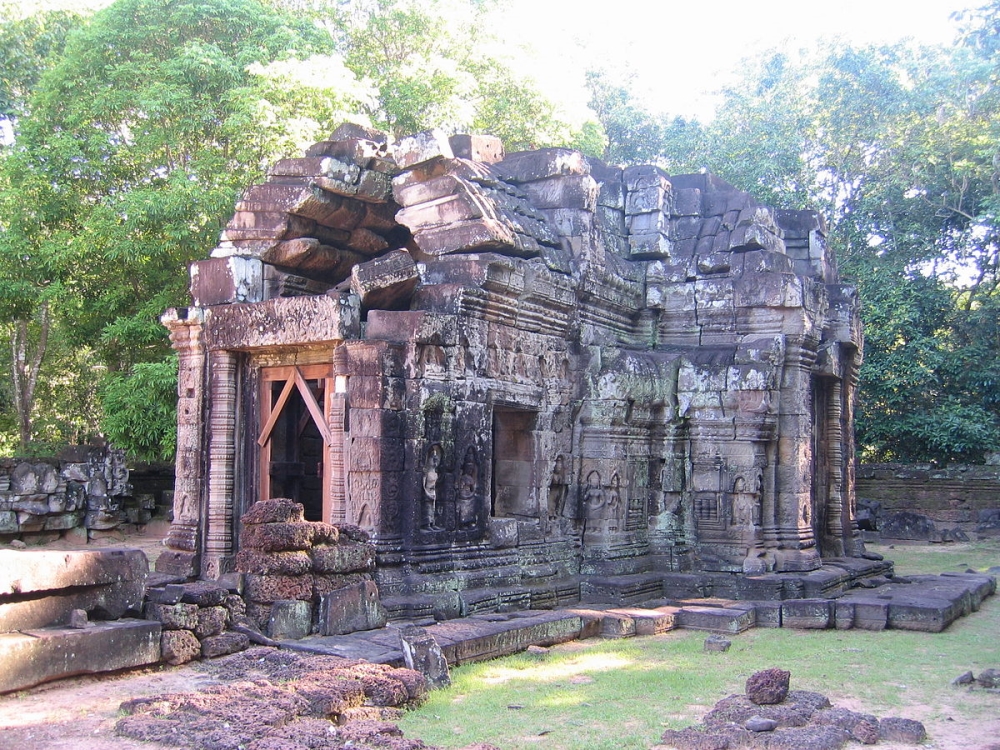
A small temple with a single central tower surrounded by two laterite walls. Pediments displaying the most interesting carvings at the site are on the ground along the enclosure wall. Krol Ko is comparatively untouristed, offering a peaceful respite.
Neak Pean
Constructed: Late 12th century C.E.
Religion: Buddhist
King/Patron: Jayavarman VII
Style: Bayon
A small island temple located in the middle of the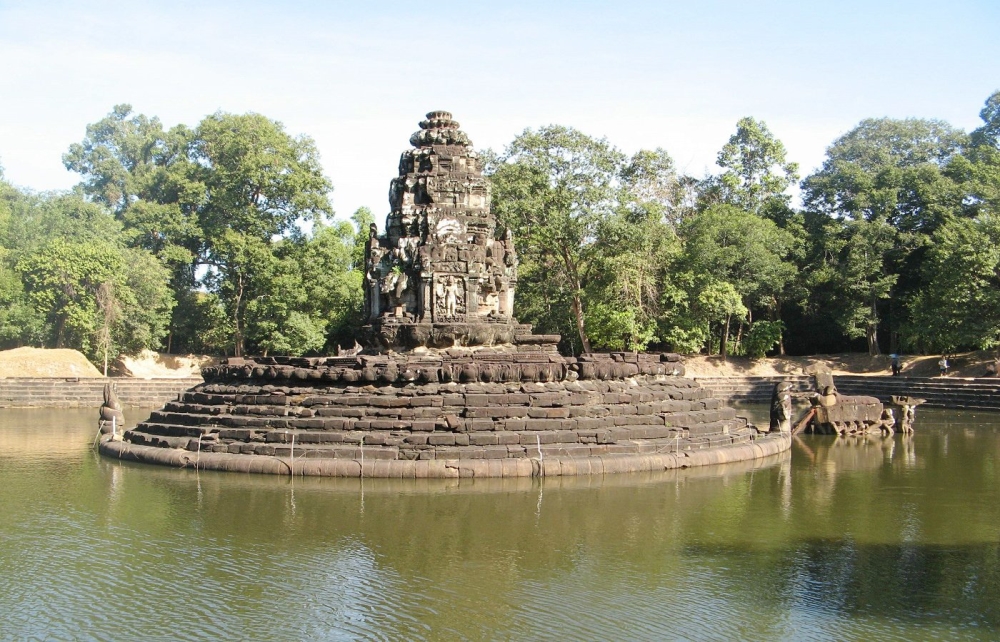 last baray (the Preah Khan Baray or Jayatataka) to be constructed by a Khmer king in the Angkor area. The central temple sits at the axis of a cross or lotus pattern of eight pools. Originally known as Rajasri, Neak Pean took its modern appellation, which means ‘coiled serpents,’ from the encoiled nagas that encircled the temple. The temple is faced by a statue of the horse, Balaha, saving drowning sailors. Though originally dedicated to Buddha, Neak Pean contains several Hindu images. Neak Pean may have served an absolution function, and the waters were thought to have healing properties. During the dry season when the water is low, check out the animal and human headwater spouts at the outside center of each pool. Neak Pean is most photogenic in the wet season when the pools are full.
last baray (the Preah Khan Baray or Jayatataka) to be constructed by a Khmer king in the Angkor area. The central temple sits at the axis of a cross or lotus pattern of eight pools. Originally known as Rajasri, Neak Pean took its modern appellation, which means ‘coiled serpents,’ from the encoiled nagas that encircled the temple. The temple is faced by a statue of the horse, Balaha, saving drowning sailors. Though originally dedicated to Buddha, Neak Pean contains several Hindu images. Neak Pean may have served an absolution function, and the waters were thought to have healing properties. During the dry season when the water is low, check out the animal and human headwater spouts at the outside center of each pool. Neak Pean is most photogenic in the wet season when the pools are full.
Phimeanakas temple
Constructed: Late 10th – Early 11th century C.E.
Religion: Hindu
King/Patron: Jayavarman V
Style: Kleang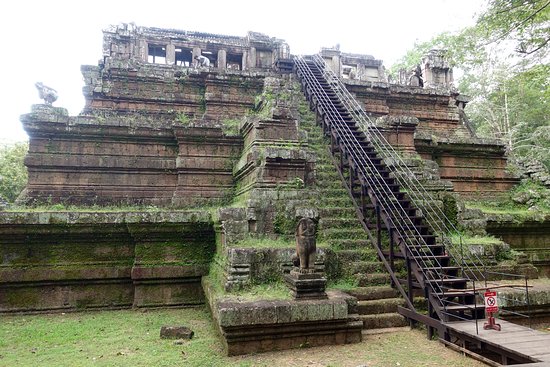
Impressive laterite and sandstone pyramid. The lack surviving carvingleaves it artistically uninteresting. But it is the tallest scalable temple in Angkor Thom, providing a nice view from the top. The western staircase (at the back) is the most easily ascended. Located inside the ancient Royal Palace compound, Phimeanakas served as the king’s temple. Legend has it that the golden tower crowned the temple and was inhabited by a serpent, which would transform into a women. The kings of Angkor were required to make love with the serpent every night, lest disaster befall him or the kingdom.
Prasat Bei temple
Constructed: 10th century C.E.
Religion: Hindu (Shiva)
King/Patron: Yasovarman I
Style: Bakheng
A set of three brick towers between Baksei Chamkrong and the moat of Angkor Thom near the South Gate. The central prasat rises 10 meters.
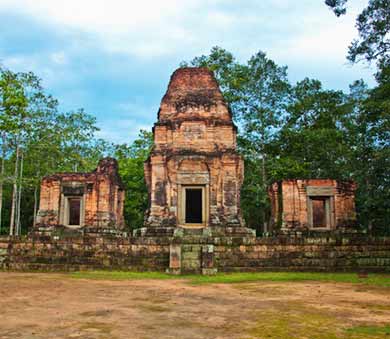 Construction was never completed. Some lintel carvings survive. Prasat Bei literally means ‘towers three.’ Best lighting in the morning.
Construction was never completed. Some lintel carvings survive. Prasat Bei literally means ‘towers three.’ Best lighting in the morning.
Prasat Suor Prat
Constructed: Early 13th century C.E.
King/Patron: Jayavarman VII
Style: Bayon/ Post-Bayon
Twelve nearly identical laterite and sandstone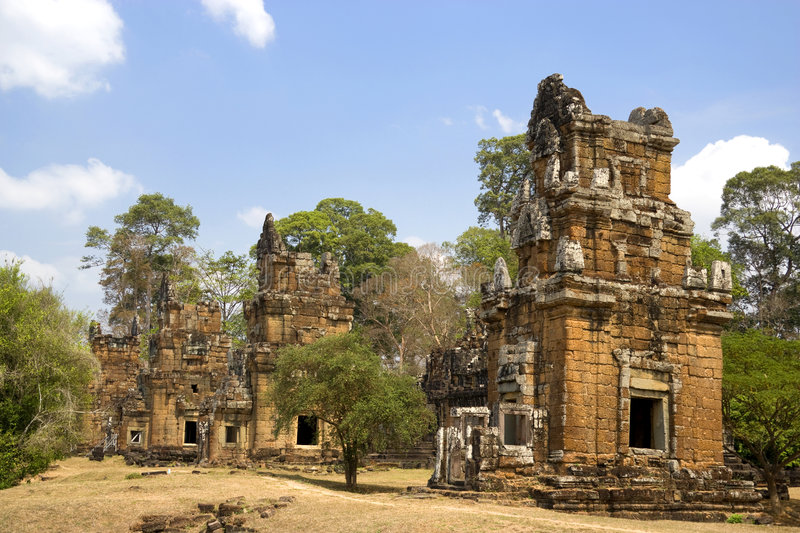 towers that stand opposite and parallel to the Terrace of the Elephants. The artistic and architectural style of the towers is somewhat unique, defying easy classification and dating. Construction may have begun under Jayavarman VII, but the towers do not display the classic Bayon-style characteristics. It has been argued that they may be post-Bayon or perhaps much earlier, as early the 11th century. The original function of the towers is a matter of debate but in the 13th century classic, “Customs of Cambodia,” Chinese emissary to Angkor, Zhou Daguan, gives a romantic but dubious firsthand account of their function. He wrote that the towers were used to settle legal disputes and matters of criminal justice. The belligerent parties were kept in the towers for a few days. The one to emerge in ill health was declared the loser, Guilty by divine decree. Best photographed in the late afternoon.
towers that stand opposite and parallel to the Terrace of the Elephants. The artistic and architectural style of the towers is somewhat unique, defying easy classification and dating. Construction may have begun under Jayavarman VII, but the towers do not display the classic Bayon-style characteristics. It has been argued that they may be post-Bayon or perhaps much earlier, as early the 11th century. The original function of the towers is a matter of debate but in the 13th century classic, “Customs of Cambodia,” Chinese emissary to Angkor, Zhou Daguan, gives a romantic but dubious firsthand account of their function. He wrote that the towers were used to settle legal disputes and matters of criminal justice. The belligerent parties were kept in the towers for a few days. The one to emerge in ill health was declared the loser, Guilty by divine decree. Best photographed in the late afternoon.
Preah Palilay
Constructed: 13th century C.E. or later
Religion: Buddhist
Style: Post-Bayon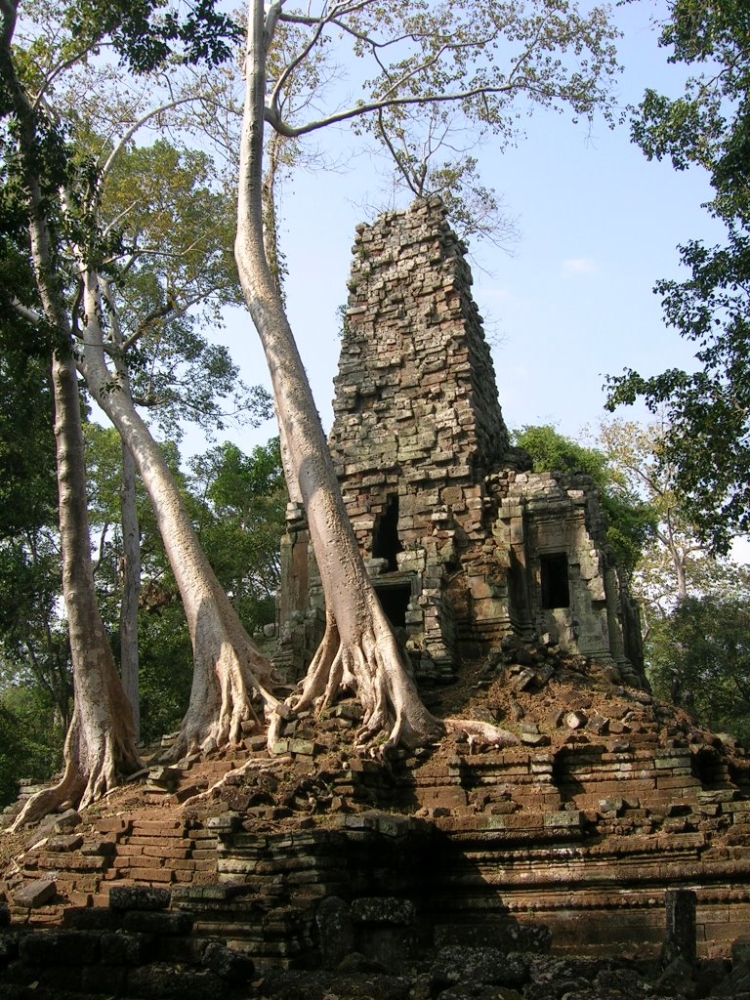
Picturesque sandstone and laterite tower in a cool, shaded forest setting, in the area behind the Terrace of the Leper King. The central tower is in rough condition but the eastern gopura displays some particularly nice Buddhist-themed carvings. The date of construction is a matter of some debate. Traditionally dated to the late 12th/early 13th century, but the Theravadan Buddhist themes of some of the carvings and some architectural features suggest a construction date in the late 13th or 14th century. The tower was rebuilt and modified in the post-Bayon period.
Preah Pithu Group
Constructed: Early 12th century C.E
Religion: Hindu
King/Patron: Suryavarman II
Style: Angkor Wat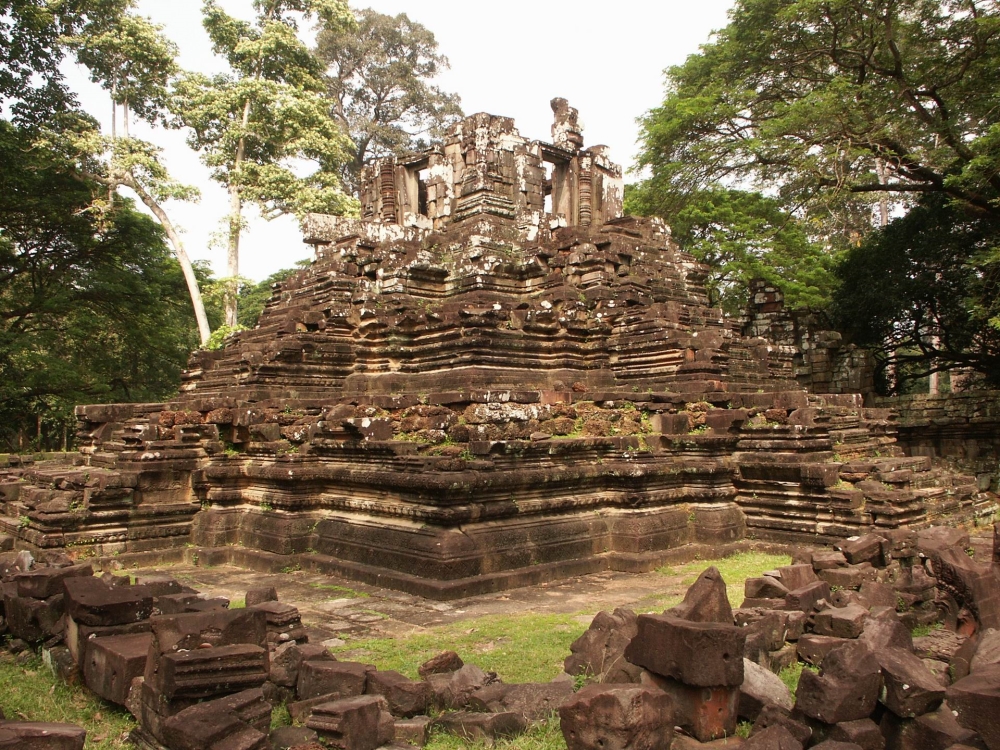
Five small temples set in a quiet area opposite the Terrace of the Leper King. Most of the construction is from the 12 th century but one of the temples is Buddhist and may date from the 14th century. The temples are in rough shape but there are interesting carved lintels scattered on the ground. Located in central Angkor Thom but not as touristed as the other temples in area. Peaceful little jungle area behind the group.
Pub Street
In Siem Reap, after returning from the temple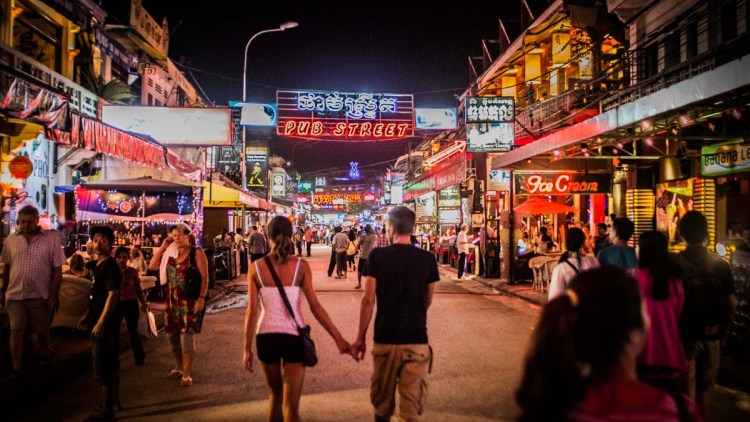 tours in the evening, many tourists are taken to the Pub Street to take advantage of the happy hour deals or a good meal. The street is so named because it is lined end to end on both sides by pubs, restaurants and shops. The street is closed to traffic in the evening; allowing pedestrians to stroll about freely. The street comes alive when the bars crank up the music and join the restaurants to spill their seats out onto the curbs. On this street, one can find bars and restaurants serving drinks and food of almost all culture and flavours. Here too are a few fine galleries for the discerning to enjoy.
tours in the evening, many tourists are taken to the Pub Street to take advantage of the happy hour deals or a good meal. The street is so named because it is lined end to end on both sides by pubs, restaurants and shops. The street is closed to traffic in the evening; allowing pedestrians to stroll about freely. The street comes alive when the bars crank up the music and join the restaurants to spill their seats out onto the curbs. On this street, one can find bars and restaurants serving drinks and food of almost all culture and flavours. Here too are a few fine galleries for the discerning to enjoy.
Ta Keo
Constructed: Late 10th – Early 11th century C.E.
Religion: Hindu (Shiva)
King/Patron: Jayavarman V
Style: Khleang
Towering but plainly decorated temple-mountain dedicated to Shiva. Known in its time as ‘the mountain with golden peaks.’ The first to be constructed wholly of sandstone, this temple employing huge sandstone blocks. Constructed under three kings, begun by Jayavarman V as his state-temple and continued under Jayaviravarman and Suryavarman I. When Jayavarman V first constructed Ta Keo, he part ways with previous kings, constructing his state temple outside of his main capital area. Construction on Ta Keo seems to have stopped particularly early in the decoration phase as evidenced by the lack of carvings. Ta Keo is well worth a visit, but if you are pressed for time, see Pre Rup instead.
Ta Nei temple
Constructed: Mid 12th century C.E.
Religion: Buddhist
King/Patron: Jayavarman VII
Style: Bayon
Small (55m x 47m), semi-ruined, untouristed jungle temple reminiscent of Ta Som, displaying classic Jayavarman VII period artistry. Some of the apsara and lintel carvings are in pretty good condition. In much rougher shape than most of the temples on the main tour circuit. The primary road to Ta Nei from where it meets the Grand Circuit road near the Southeast corner of Ta Keo was closed on last inspection. To get to Ta Nei, park at the end of the road near Ta Keo and walk the dirt road about 1km to Ta Nei, or by motorcycle, follow unmarked dirt road from just outside the Victory Gate of Angkor Thom to the ‘French Dam.’ Cross the dam and proceed 200m up a small path.
Ta Promh Kel
Constructed: Late 12th century C.E.
Religion: Buddhist
King/Patron: Jayavarman VII
Style: Bayon
A single small sandstone tower located opposite Angkor Wat, Ta Prohm Kel is the ruin of the temple or ‘chapel’ of one of the 102 hospitals built by Jayavarman VII throughout the kingdom. Of very similar design and state of ruin to the Chapel of the Hospital near Ta Keo. The Buddhist-themed carving on the northern pediment is in fair condition and displays marks of vandalism cgaracteristic of the 13th century Hindu resurgence. The coarsely rendered carving on the interior of the temple are probably from a much latter period.
Ta Som
Constructed: Late 12th century C.E.
Religion: Buddhist
King/Patron: Jayavarman VII
Style: Bayon
Small, classic Bayon-style monastic complex consisting of a relatively flat enclosure, face tower gopuras and cruciform interior sanctuaries much like a miniature version of Ta Prohm. Many of the carvings are in good condition and display particularly fine execution for late 12th century works. Take note of the devata carvings which show an uncommon individuality. A huge tree grows from the top of the eastern gopura. It is des-toying the gate but it is a photo classic. Best photographed in the afternoon. Ta Som is the most distant temple on the Grand Circuit.
Terrace of the Leper King
Constructed: Late 12th century C.E.
Religion: Buddhist
King/Patron: Jayavarman VII
Style: Bayon
A double terrace wall at the north end of the Terrace of Elephants with deeply carved nagas, demons and other mythological beings. The inner wall is an earlier version of the outer wall that was covered at the time the outer wall was added.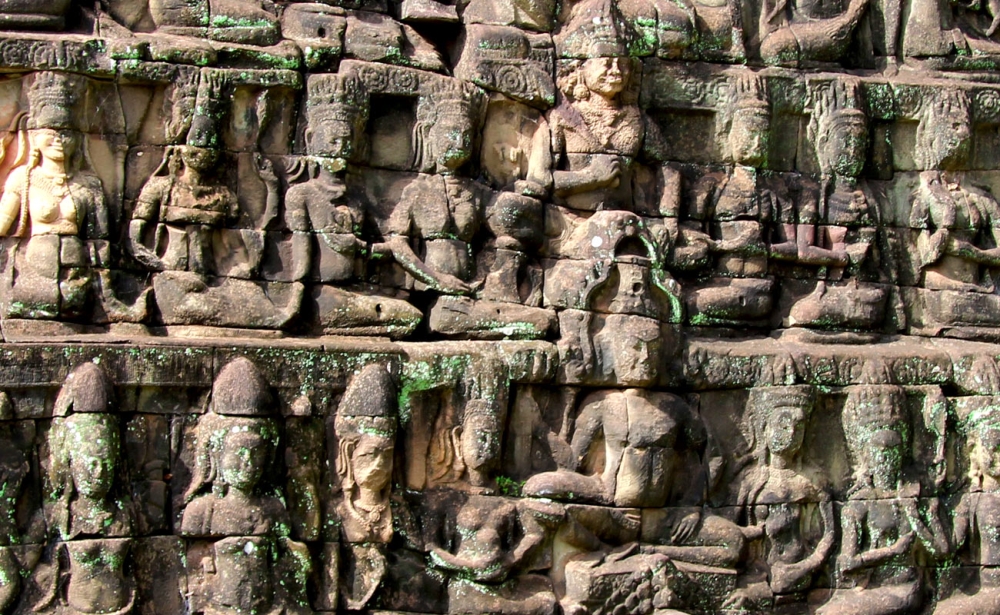 The inner wall was excavated by French archaeologists in the late 1990s. The terrace was named for the statue of the ‘Leper King’ that sits on top. Why the statue is known as the ‘leper king’ is a matter of debate. Some argued that when the statue was found, its lichen-eaten condition gave it the appearance of leprosy. Others have argued that it is a statue of the leper king of Khmer legend, or that the condition of the statue inspired its connection to the legend. The model for the statue is also a matter of debate. Suggestions include a couple of different Hindu gods, and the Khmer kings Yasovarman I and Jayavarman VII. Recent scholarship favors a combination of Jayavarman VII and Buddha. The statue of the leper king on display at the terrace is a replica. The original resides in the National Museum in Phnom Penh.
The inner wall was excavated by French archaeologists in the late 1990s. The terrace was named for the statue of the ‘Leper King’ that sits on top. Why the statue is known as the ‘leper king’ is a matter of debate. Some argued that when the statue was found, its lichen-eaten condition gave it the appearance of leprosy. Others have argued that it is a statue of the leper king of Khmer legend, or that the condition of the statue inspired its connection to the legend. The model for the statue is also a matter of debate. Suggestions include a couple of different Hindu gods, and the Khmer kings Yasovarman I and Jayavarman VII. Recent scholarship favors a combination of Jayavarman VII and Buddha. The statue of the leper king on display at the terrace is a replica. The original resides in the National Museum in Phnom Penh.
Thma Bay Kaek temple
Constructed: Early 10th century C.E.
Religion: Hindu (Shiva)
King/Patron: Yasovarman I
Style: Bakheng
The spare remains of a brick prasat, now disappeared, leaving only a doorframe, lintel and a bit of the terrace. A sacred relic of five gold leaves, one bearing the images of Nandi (Shiva’s bull),
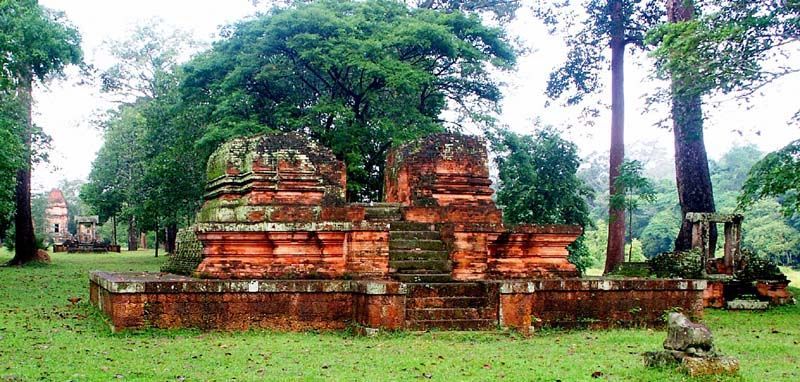
was discovered at this site. Combine with visit to Prasat Bei/Baksei Chamkrong.
Thomanon
Constructed: Late 11th – Early 12th century C.E.
Religion: Hindu
King/Patron: Suryavarman II
Style: Angkor Wat
Small, attractive temple in very good condition, built at the same time as Angkor Wat. The Angkor Wat style is most easily seen in the style of the towers and carved devatas.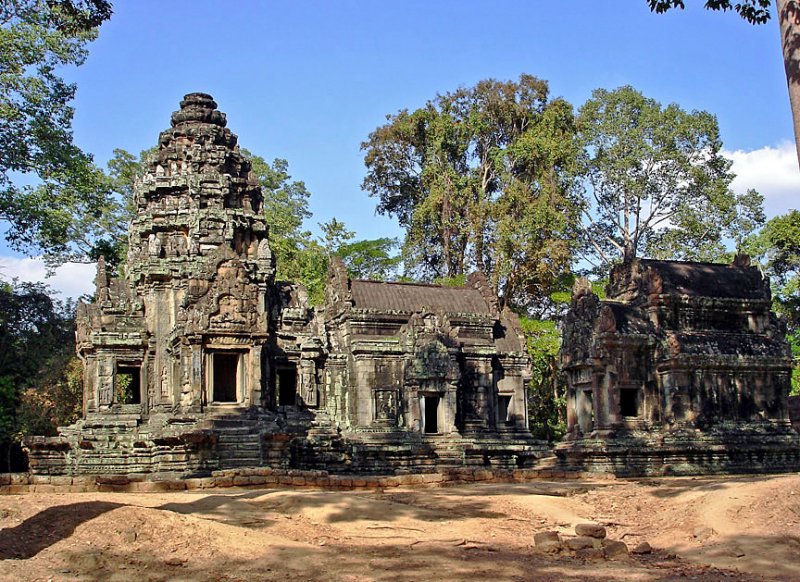 Thommanon seems to stand in conjunction with Chau Say Tevoda across the street, but was built decades earlier. Thommanon is currently in much better condition than Chau Say Tevoda, in part because archaeologists heavily restored it in the 1960’s. But even before restoration, Thommanon was in better shape than Chau Say Tevoda due in part to the lack of the stone-enclosed wood beams in Thommanon’s super-structure that were used in Chau Say Tevoda’s construction. Many of Thommanon’s carvings are in excellent condition. The colors of the age stained sandstone against the jungle are very photogenic, particularly in the wet season.
Thommanon seems to stand in conjunction with Chau Say Tevoda across the street, but was built decades earlier. Thommanon is currently in much better condition than Chau Say Tevoda, in part because archaeologists heavily restored it in the 1960’s. But even before restoration, Thommanon was in better shape than Chau Say Tevoda due in part to the lack of the stone-enclosed wood beams in Thommanon’s super-structure that were used in Chau Say Tevoda’s construction. Many of Thommanon’s carvings are in excellent condition. The colors of the age stained sandstone against the jungle are very photogenic, particularly in the wet season.
Wat Athva
Constructed: Late 11th century C.E.
Religion: Hindu
King/Patron: Suryavarman II
Style: Angkor Wat
Though lacking carvings, this laterite and sandstone temple is still in relatively good condition. It bears no inscriptions to allow precise dating but seems to have been constructed employing Angkor Wat architectural style, which is particularly apparent in the towers, suggestive of late 11th century construction.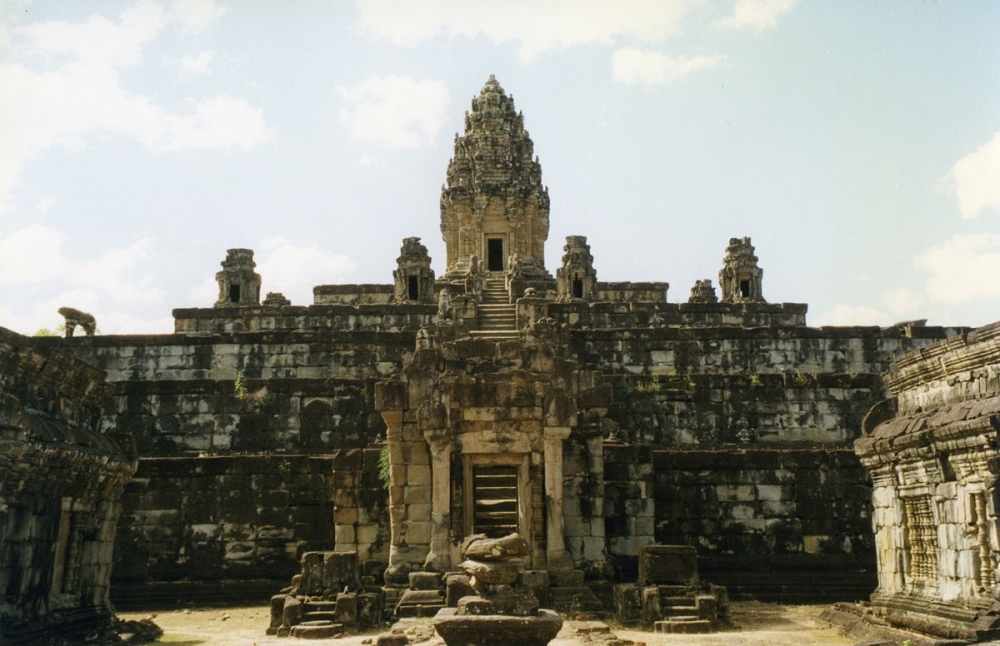 This temple seems to have been left unfinished as evidenced in part by the lack of carvings. Some of the apsara carvings were abandoned half finished. It is next to an active wat of the same name. Because it is well outside the regular temple complex, it is relatively untouristed. Located 7km south of town, 200m off the main road from town to the Tonle Sap. Look for a white concrete arch/sigh at the turnoff to the wat. For a countryside sunset. Follow the dirt road for a kilometer or two past the wat. Palm trees and small huts lining the road open to rice paddies and Phnom Krom on the horizon.
This temple seems to have been left unfinished as evidenced in part by the lack of carvings. Some of the apsara carvings were abandoned half finished. It is next to an active wat of the same name. Because it is well outside the regular temple complex, it is relatively untouristed. Located 7km south of town, 200m off the main road from town to the Tonle Sap. Look for a white concrete arch/sigh at the turnoff to the wat. For a countryside sunset. Follow the dirt road for a kilometer or two past the wat. Palm trees and small huts lining the road open to rice paddies and Phnom Krom on the horizon.
Bakong
Constructed: Late 9th century C.E.
Religion: Hindu
King/Patron: Indravarman I
Style: Preah Ko
Roluos Group: The most impressive member of the Roluos Group, sitting at the center of the first Angkorian capital. Hariharalaya. Bakong stands 15 meters tall and is 650x850m at the outer wall.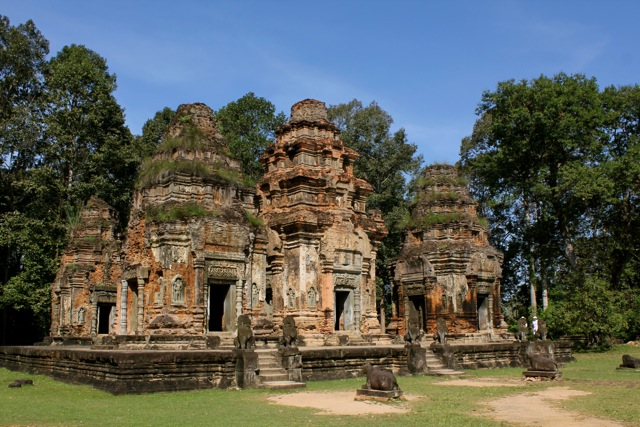 Constructed by the third Angkorian-era king as his state-temple, Bakong represents the first application of the temple-mountain architectural formula on a grand scale and set the architectural tone for the next 400 years. The temple displays a very early use of stone rather than brick. Though begun by Indravarman I, Bakong received additions and was expanded by later kings. The uppermost section and tower may have been added as late as the 12th century AD. Some of the lintel carvings, particularly on the outer towers, are in very good shape. Picturesque moat and vegetation surround Bakong.
Constructed by the third Angkorian-era king as his state-temple, Bakong represents the first application of the temple-mountain architectural formula on a grand scale and set the architectural tone for the next 400 years. The temple displays a very early use of stone rather than brick. Though begun by Indravarman I, Bakong received additions and was expanded by later kings. The uppermost section and tower may have been added as late as the 12th century AD. Some of the lintel carvings, particularly on the outer towers, are in very good shape. Picturesque moat and vegetation surround Bakong.
Preah Ko
Constructed: Late 9th century C.E.
Religion: Hindu (Shiva)
King/Patron: Indravarman I
Style: Preah Ko
Roluos Group: Six towers displaying set on a platform, all beautifully preserved carvings. Originally surrounded by walls and gopuras of which only vestiges remain.
 Preah Ko was one of the first major temples of the empire at the early Khmer capital of Hariharalaya. Preah Ko (Sacred Bull) derives its name from the statues of bulls at the front of the central towers.
Preah Ko was one of the first major temples of the empire at the early Khmer capital of Hariharalaya. Preah Ko (Sacred Bull) derives its name from the statues of bulls at the front of the central towers.
Lolei
Constructed: Late 9th century C.E.
Religion: Hindu
King/Patron: Yasovarman I
Style: Preah Ko/ Bakheng
Roluos Group: Ruins of an island-temple built in the middle of a now dry baray, Indratataka, the first large-scale baray constructed by a Khmer king.

Lolei consists of four brick towers on a double laterite platform.
It was the last major temple built at Roluos before Yasovarman I moved the capital to the Angkor area. Though the towers are in poor condition, there are some lintel carvings in very good condition displaying the distinctively detailed Preah Ko style.
An active pagoda has been built amongst the ruins. Of the Roluos Group ruins, allocate the least time Lolei. See ´Roluos Group´ and ´Baray´.
Koh Ker
The temple complex at Koh Ker, northeast of Siem Reap, represents the remnants of the capital of the Khmer Empire from 928 AD. – 944 A.D. – a very unique period in the Age of Angkor. From the time the Khmer capital was first moved to the Angkor area in the late 9 th century, it would remain there for almost 500 years, with one brief interruption. Just a few decades after the establishment at Angkor there was a disruption in the royal succession for reasons that remain a matter of academic debate. What is known is that in 928 A.D. King Jayavarman IV, possibly a usurper to the throne, created a new capital 100km away at Koh Ker, either moving the capital city from Angkor or creating a rival capital. Obviously a king of much wealth and power, he raised an impressive royal city at Koh Ker of Brahmanic monuments, temples and prasats, surrounding a huge baray (reservoir) Rahal. Jayavarman IV reigned at Koh Ker for 20 years before he died in 941 A.D. His son Hashavarman II would remain at Koh Ker for another 3 years before returning the capital to the Angkor area. The monuments of Koh Ker are now on a road loop around the baray past the most importants temples. The premier ruin of the complex is Prasat Thom, an imposing 7-tiered pyramid and temple complex. (Best photographed in the morning and offering a bird’s eye view from the top.) As you round the loop, there are several nicely preserved ruins sit just off the road., impressive prasats and small temple complexes. There are lingas still in place in some monuments such as Prasat Balang and Prasat Thneng. For the enthusiast, there are also dozens of other, more remote ruins in the area. A good guide can be most helpful at Koh Ker. A trip to Koh Ker takes the better part of a day out of Siem Reap and is usually combined with a visit to Beng Melea. To get there take Route #6 east from Siem Reap to Damdek. Turn north and follow the sign. Part of the way is a toll road. Check road conditions before leaving Siem Reap, especially in the wet season. $10 entrance fee to Koh ker.
What is known is that in 928 A.D. King Jayavarman IV, possibly a usurper to the throne, created a new capital 100km away at Koh Ker, either moving the capital city from Angkor or creating a rival capital. Obviously a king of much wealth and power, he raised an impressive royal city at Koh Ker of Brahmanic monuments, temples and prasats, surrounding a huge baray (reservoir) Rahal. Jayavarman IV reigned at Koh Ker for 20 years before he died in 941 A.D. His son Hashavarman II would remain at Koh Ker for another 3 years before returning the capital to the Angkor area. The monuments of Koh Ker are now on a road loop around the baray past the most importants temples. The premier ruin of the complex is Prasat Thom, an imposing 7-tiered pyramid and temple complex. (Best photographed in the morning and offering a bird’s eye view from the top.) As you round the loop, there are several nicely preserved ruins sit just off the road., impressive prasats and small temple complexes. There are lingas still in place in some monuments such as Prasat Balang and Prasat Thneng. For the enthusiast, there are also dozens of other, more remote ruins in the area. A good guide can be most helpful at Koh Ker. A trip to Koh Ker takes the better part of a day out of Siem Reap and is usually combined with a visit to Beng Melea. To get there take Route #6 east from Siem Reap to Damdek. Turn north and follow the sign. Part of the way is a toll road. Check road conditions before leaving Siem Reap, especially in the wet season. $10 entrance fee to Koh ker.
Preah Khan of Kampong Svay
Constructed: 11th – late 12th century C.E.
Religion: Buddhist
King/Patron: Suryavarman I & II and Jayavarman VII
A jungle temple of many names: Preah Khan of Kampong Svay, Preah Khan of Kampong Thom and Prasat Bakan. Preah Khan is a massive monastic complex enclosing near five square kilometers, originally constructed under Suryavarman I but receiving addition and modification by later kings.
 Most of the carvings have been looted or removed including a bust of Jayavarman VII which has become and iconic image and much reproduced. Located about 100 km east of Beng Melea this temple is difficult to reach by road. Requiring the better part of a day to get there, but only adding to its ‘magical’ atmosphere.
Most of the carvings have been looted or removed including a bust of Jayavarman VII which has become and iconic image and much reproduced. Located about 100 km east of Beng Melea this temple is difficult to reach by road. Requiring the better part of a day to get there, but only adding to its ‘magical’ atmosphere.
Around Siem Reap
The reason most people come to Siem Reap is to visit the Angkor Archaeological Park. The town is worth strolling about for itself and there are a number of means to go about enjoying the city.
Going about on foot is perhaps the most leisurely and most rewarding. Here, the pace may be quite laid-back to some, but all in all it’s a pleasant place to be at. Along the streets, there are many shops offering services and goods ranging from the basic necessities to fine silk; chic galleries with beautiful display of local art pieces and lots of souvenirs.
For food, there are whole streets catering for the travellers tastes, with tasty Khmer fares such as Amok and ‘Khmer curry’, or pizzas, hamburgers and other international cuisines. Explore the backstreets for more shops and restaurants and have fun. In the evening, stroll down Pub Street and mingle with the crowd. There is never a lack of colours while in Siem Reap.
Angkor Ballon
It is situated in road from airport to Angkor Wat, 1km west of Angkor Wat, Siem Reap. Opening time is from 6:00 to 17:00. During visiting Baken Mountain, a huge yellow balloon on the sky can be seen from a distance. It is a hydrogen balloon anchored by crude steel, around 70m from the ground to sky, straight up and straight down, around 10 minutes for one time. Although it is not the real fight in the sky, but it is able to view Angkor Wat, Baken Mountain, endless plain, farmland and village, and the scenery is very good.
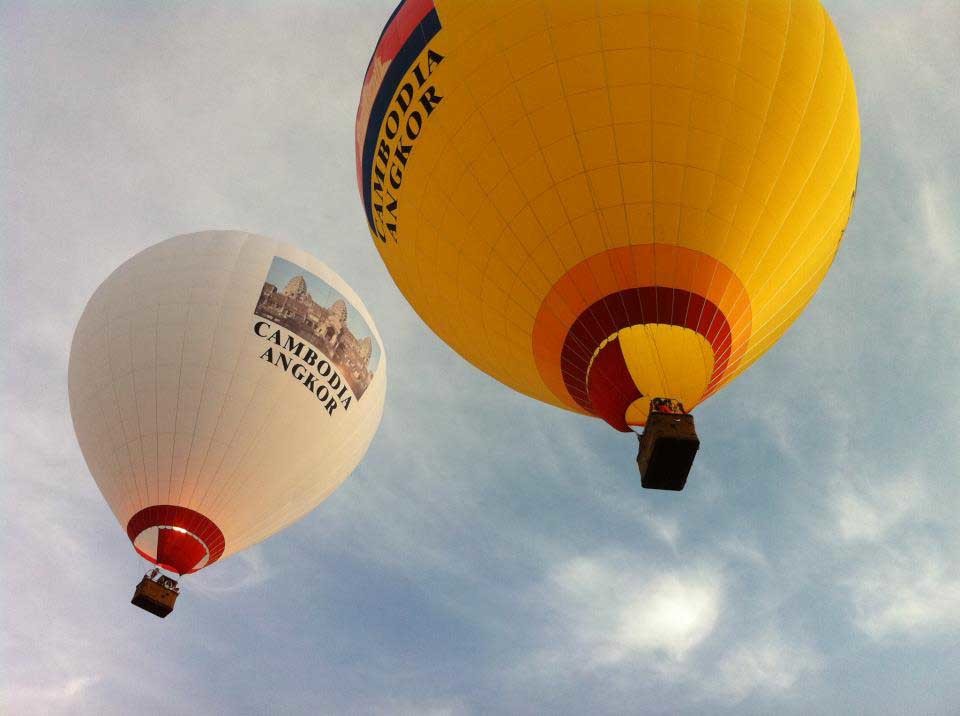
The balloon liftoff or not is dependent on the weather and season, and the best way to know is to ask the guide or hotel staff help to ask.
War Museum
The Museum is situated in Kacam Village of Siem Reap Province, and opening time is from 8:00 to 15:30. It displays the used weapon in Pol Pot period, including Soviet Union’s and China’s helicopter, tank, hand grenade, rifle, missile wreckage and army used product, etc.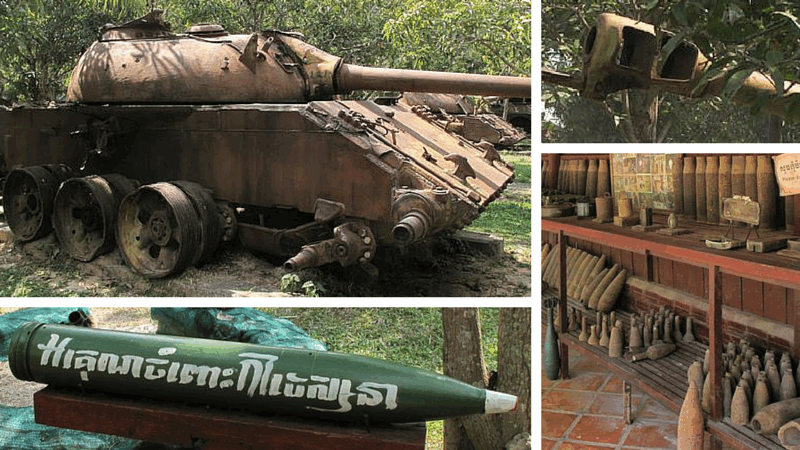 All have the English name but not very detailed description, but the guide is available on the field for interpretation.
All have the English name but not very detailed description, but the guide is available on the field for interpretation.
Landmine Museum
It is situated on the way to Banteay Srei Temple, Siem Reap. It was founded by a veteran using most of his saving. He used to do the landmine removal work, so he has collected around 5000 removal landmines and wartime weapons displayed in the museum.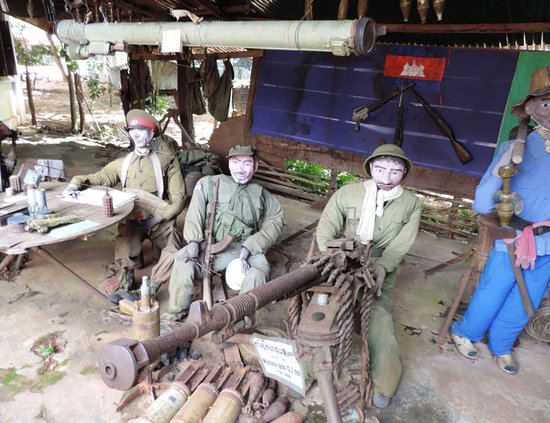 There are also pictures and stories of victims and introduction about landmine removal work in the museum. Every Monday, Tuesday, Thursday and Friday, from 9:00 to 15:00, there are English, Japanese tour guides to let everyone understand more about the history of that period.
There are also pictures and stories of victims and introduction about landmine removal work in the museum. Every Monday, Tuesday, Thursday and Friday, from 9:00 to 15:00, there are English, Japanese tour guides to let everyone understand more about the history of that period.
Preah Norodom Shihanuk-Angkor Museum
It is situated in Boeung Don Pa Village, Slakram Commune, Siem Reap. It was opened in 2008. In the museum, 274 Buddha statues explored at Banteay Kdei Temple from 2000 to 2001 by Angkor heritage survey team of Sophia University and the process of excavation are displayed. Each Buddha statue has a detailed English description. Some of the exhibits are copies, being allowed to be touched.
In the museum, 274 Buddha statues explored at Banteay Kdei Temple from 2000 to 2001 by Angkor heritage survey team of Sophia University and the process of excavation are displayed. Each Buddha statue has a detailed English description. Some of the exhibits are copies, being allowed to be touched.
Royal Garden
There is a small palace which the king stays in the garden; it is smaller if compare with the palace in Phnom Penh. The palace does not open for visitors but allows to be watched in a close distance. In front of the palace is the large level garden situated the riverside, and the grass looks like a green carpet, making a very comfortable feeling. In the garden, there are two pagodas with heyday incense such as Ya Tap Shrine and Preah Ang Chek pagoda.
 However, the objective of most tourists coming here is to watch thousands of bats hanging on the tree behind the pagoda during the daytime which is a very rare phenomenon.
However, the objective of most tourists coming here is to watch thousands of bats hanging on the tree behind the pagoda during the daytime which is a very rare phenomenon.
Crocodile Farm
It is located in Wat Sway Village, Sway Dongkum commune, Siem Reap, opening time is from 7:00 to 9:00, and entrance fee is 3 USD. The farm is run by government in order to raise the crocodiles captured in the Tonle Sab Lake.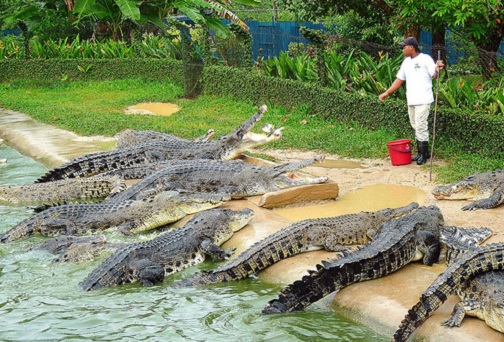 In the peak period, it is said that there are nearly 1000 crocodiles in the small farm; later, because of the financial problem, some of the crocodiles are resold to the crocodile skin dealer, leading to the decrease of the crocodile number at the present. However, there are still many crocodiles. There is a place for buying feed, even live chickens and ducks can be bought at here to fee the crocodile, but it is a little bit cruel.
In the peak period, it is said that there are nearly 1000 crocodiles in the small farm; later, because of the financial problem, some of the crocodiles are resold to the crocodile skin dealer, leading to the decrease of the crocodile number at the present. However, there are still many crocodiles. There is a place for buying feed, even live chickens and ducks can be bought at here to fee the crocodile, but it is a little bit cruel.
Angkor Silk Farm
It is situated in Tortea Village, Knoberiel Commune, Siem Reap. The silkworm breeding and silk center has the English, Chinese, Japanese, Korean, Spanish guides to guide visitors to visit the farm.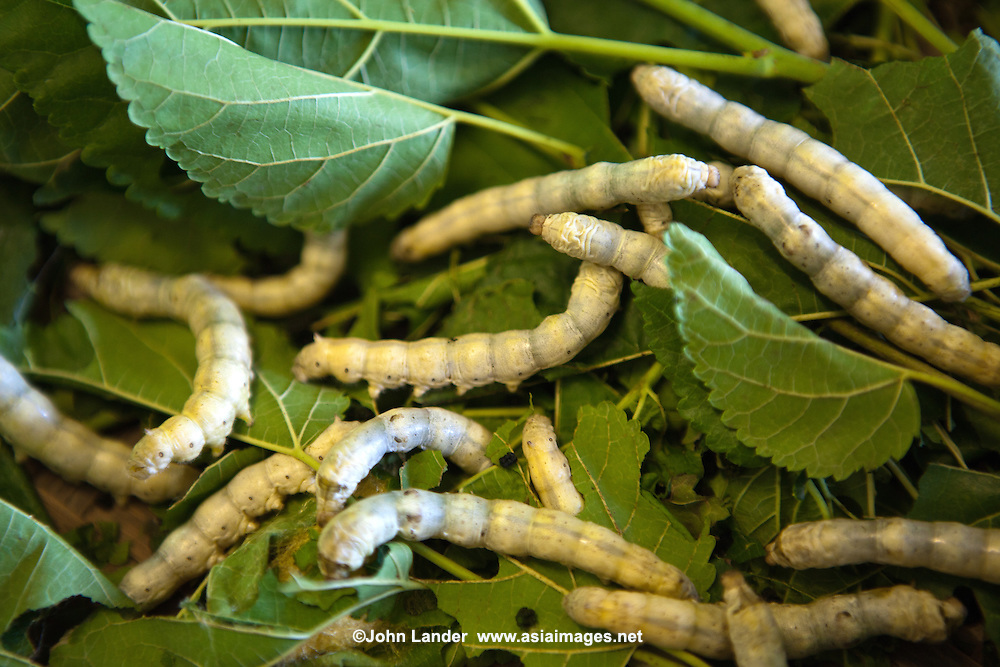 The silk farm is not the only one silk farm, but it is more special at here, and the uniqueness is that the whole process uses the traditional manual method to produce, including sericulture, spinning, dyeing and weaving. Traditional dyeing process uses the natural dye, and the unexpected thing is that one of the elements to produce the black color is the iron nail. There are café and store at here, various silk cloth and general cargo are available here.
The silk farm is not the only one silk farm, but it is more special at here, and the uniqueness is that the whole process uses the traditional manual method to produce, including sericulture, spinning, dyeing and weaving. Traditional dyeing process uses the natural dye, and the unexpected thing is that one of the elements to produce the black color is the iron nail. There are café and store at here, various silk cloth and general cargo are available here.